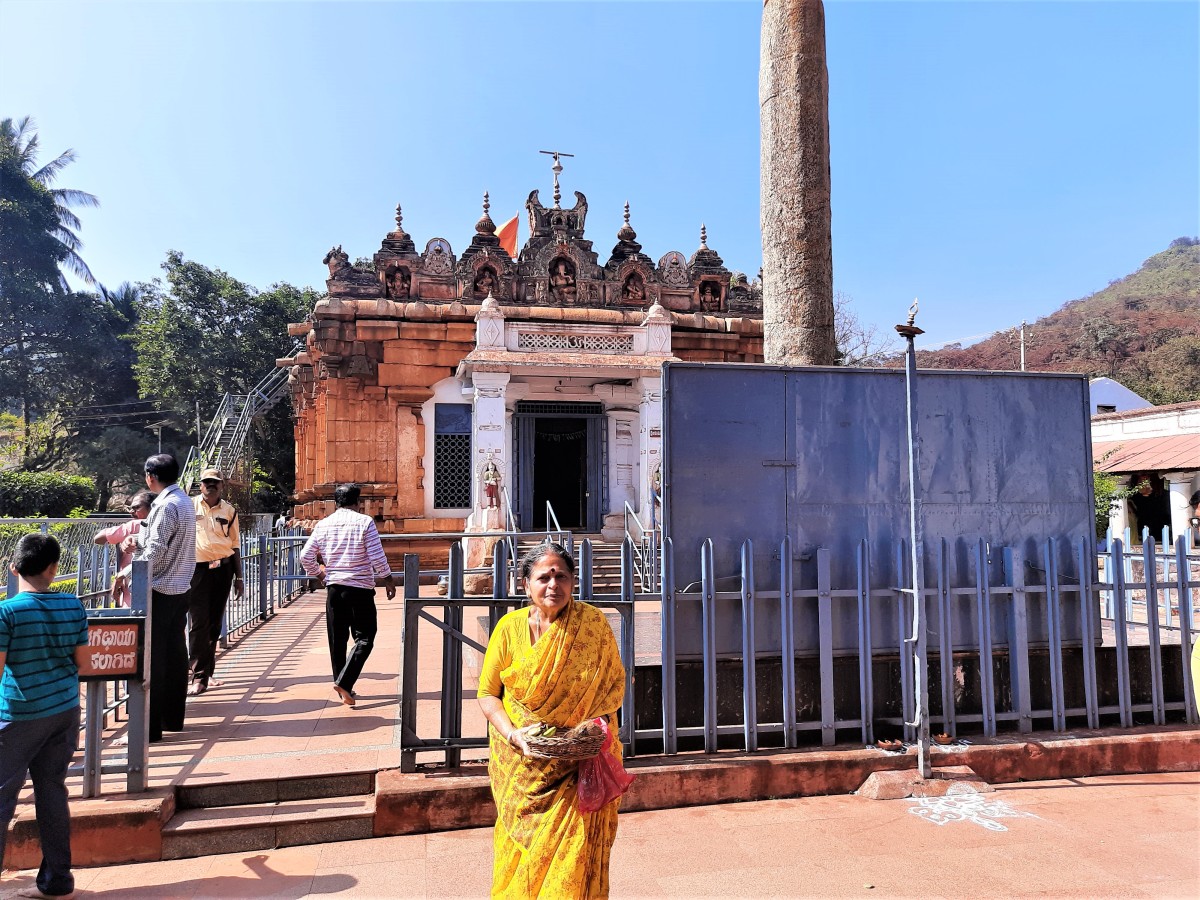Index of Contents
- Introduction
- Google Map of Central & North Karnataka Temples
- Google Maps of Implemented Tour Program Day 6,7 & 8
- Day 6
- Day 7
- Day 8
Note : Since the Blog is lengthy, If you Click on any Title, you will be taken to the concerned paragragh by the link provided. Also you can return to the Index of Contents for which links have been provided at several places in the Blog.
1 Introduction
Karnataka is a veritable treasure chest of temples and monuments. In Northern part of Karnataka, Badami, Pattadakal and Aihole showcases the temple building skills of Badami Chalukyas. Hampi region of Vijayanagara dynasty. In Central part,Belur, Halabeid etc with its beautiful temples belonging to the Hoysala Empire. Western Chalukya Empire / Kalyani Chalukya in the Tungabhadra region – Dambal, Itagi, Lakkundi etc. This blog in 4 parts covers some of the above temples visited during 13 Dec 2021 to 20 Dec 2021 (8 Days) Part 1 describes temples covered on Days 1 & 2. Part 2 of the blog describes temples covered on Days 3 & 4. Part 3 of the blog describes temples covered on Day 5. This blog describes temples covered on Days 6,7 & 8.
2 Google Map of Central & North Karnataka Temples
Embedded Interactive Google Map of North Karnataka Temples is given below. By clicking on a location, photo of the temple, web links for more details of temple, Video (Youtube) links if any can be seen.
3 Google Maps of Implemented Tour Program Day 6,7, 8



4 Day 6
Visited Hucchimalli Gudi & Ravana Phadi temples in Aihole. Next Kudalasangama Sangameshwara Temple– sangam of Krishna and Ghataprabha rivers – Built during Kalyana Chalukya times . Then Shri Kanakachala Lakshmi Narasimha Temple– built in Vijayanagara period. In the evening, Visited Gangavathi Temples: Neelakanteshwara Temple,.Nagareshwara Temple and Venkataramana Temple
4.1 Hucchimalli Gudi, Aihole
Hucchimalli Gudi, 2VFM+G8P, Aihole, Karnataka 587124 Hucchimalli Gudiis located at Aihole, Karnataka at a distance of 35 kms from Badami.
Aihole temples and monuments, also called Aivalli or Ayyavole or Aiholi temples and monuments, are a collection of over 100 temples built predominantly between 6th and 8th century near Malaprabha river in Karnataka. At this point, the river turns northwards towards the Himalayas which likely had significance as a location.
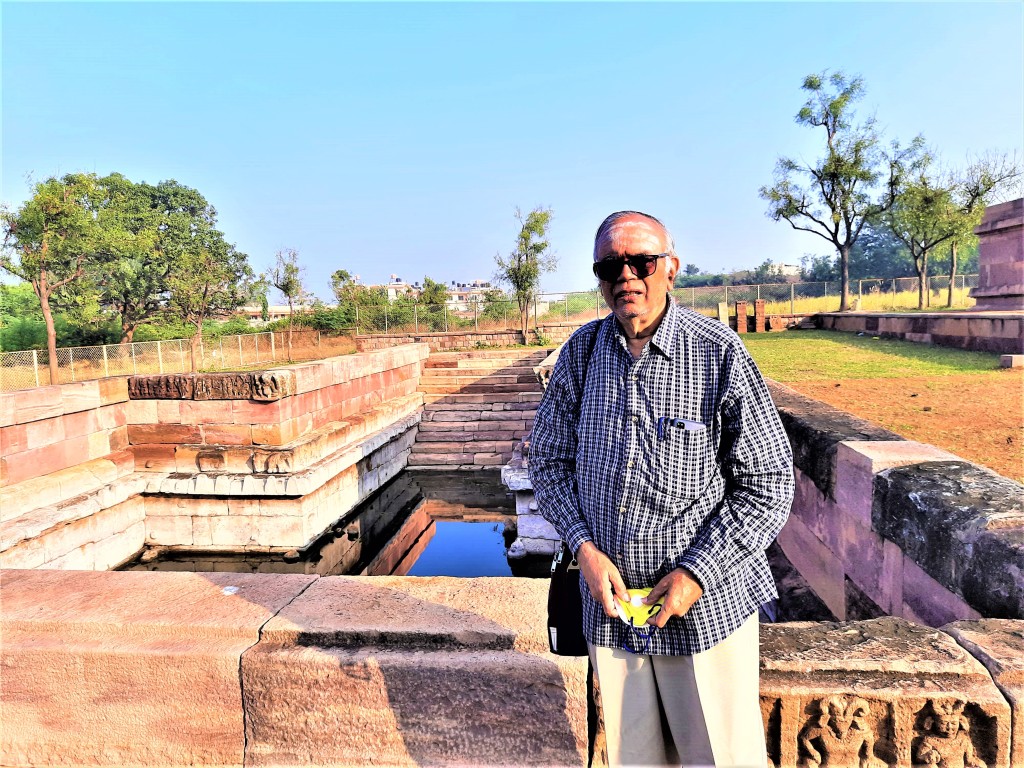
Though defaced and damaged after the region was conquered by Muslim commanders of the Delhi Sultanate, the collection is one of the earliest surviving temples and window to ancient Indian arts, religious beliefs, society and architecture. Almost all temples are related to Hinduism, but these co-exist with a few Jain temples of this period and one Buddhist monument. Both north Indian and south Indian styles fuse here, with monuments suggesting experimentation of ideas and building styles under the sponsorship of late Gupta period Hindu kingdoms, particularly the Chalukyas and Rashtrakutas.
The Hucchimalli Gudi is a Hindu temple dedicated to Shiva. The temple is relatively small, but includes architectural elements found in major later Hindu temples, such as a mukha-mandapa, a sabha-mandapa and a gabha-griha. The temple was likely built between the 6th and 8th century, and it features kama / artha scenes such as amorous couples. The temple shows images of Garuda, Brahma and Surya. The entrance of the main shrine have damaged carvings of goddess Ganga and Yamuna. The sabha-mandapa, likely used for social events such as weddings has images of Indra and Kubera.
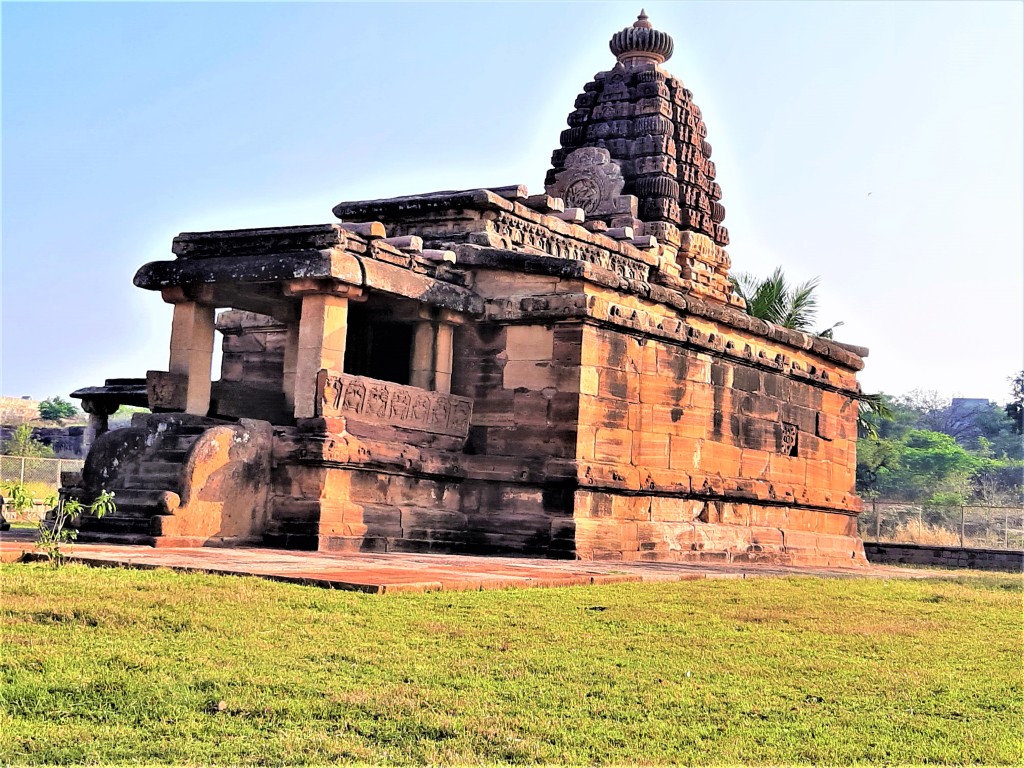
The ceiling of the temple has a carved image of one headed Kartikeya on a peacock in warrior attire with dancing angels. Near the temple is a public utility water tank. The temple and tank show images of Durga killing buffalo demon (Mahishasuramardini) and panels showing fables from the Hindu text Panchatantra.
Hucchimalli Gudi is said to be one of the earliest groups of temples at Aihole, built in the 7th century shows an evolution in the temple plan, the entrance hall in front of the sanctum was introduced for the first time here. It shows an ardhamantapa or an ante-chamber annexed to the main shrine.
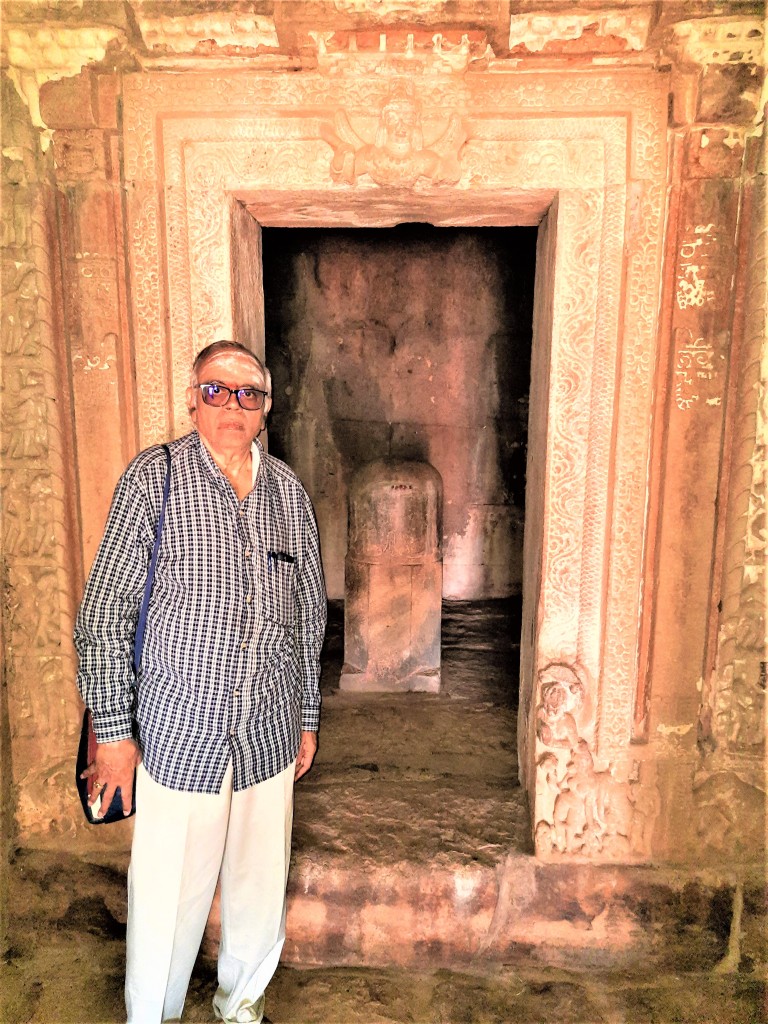
Huchimalli Gudi Temple is one of the most beautiful temples in Aihole. It is small in size , but seems to be unique in its architectural style. The temple somewhat resembles Durga Temple The temple has a huge main hall, and observes many beautiful art works.
The sanctum here has a pradakshina patha and its external walls contain lattices. The sanctum has a northern style rekhanagara tower. It is in this temple the shukanasa or the vestibule was introduced for the first time. A little away in front is another dilapidated temple. Another small temple to the north of Huchimalligudi is assigned to the 11th century. The Huchimalli Gudi is home to shrines of Lord Shiva, Vishnu and Brahma.
4.2 Ravana Phadi, Aihole
Ravana Phadi, 2VCM+XM9, Aihole, Karnataka 587124 Ravana Phadi is located at Aihole, Karnataka at a distance of 35 kms from Badami

Ravana Phadi or Ravalaphadi dates to the 6th century and is one of the oldest rock cut cave templein Aihole. It is located less than a kilometer uphill, northeast from the Durga temple complex. This is a rock-cut shrine is dedicated to Lord Shiva. Its exterior is simple with four pillars, and Padmanidhi and Shankhanidhi guards. It has a rectangular frontage and square inner wall. But the interior has on its will tall dancing Shiva with ten hands, equally tall Saptamatrikas observing Shiva’s dance, rows of beautiful Ganas, and figures of Varaha, Mahishamardini, and other artistic slender figures. The Garbhagriha has a Shivalinga with its Peetha and they are monolithic, on the walls on the sides are Mahishamardini and Varaha sculptures and Bhoodevi is seated on Varaha’s shoulder. Outside the cave there is a platform for Nandi in fone with the Linga in the Garbhagriha and a monolithic stone pillar

The entrance has an eroded fluted column and seated Nandi facing the temple sanctum, with several other small monuments. Inside the cave are three near square mandapas, the innermost featuring the Shiva linga and connected to the entrance mandapa by a rectangular space.
The entrance of the Ravanaphadi cave on left, is an image of Ardhanarishvara portraying the equivalence and essential inter dependence of the masculine left Shiva and feminine right Parvati. Past this fused image, is the first mandapa to the left of which is a niche carved space. In it is 6th century artwork showing dancing Shiva (Nataraja) with Parvati, Saptamatrikas or seven mothers of Shaktism tradition, Ganesha and Kartikeya. On the right side of the main mandapa is Harihara portraying a fused image of Shaivism and Vaishnavism, with left Shiva and right Vishnu. On the opposite wall of Harihara is Shiva with three primary river goddesses of Hindu theology, and he stands with Parvati and the skeletal ascetic Bhringi.

The main mandapa connects to two other near square mandapas. To its north is the sanctum, flanked by Shaiva guardians at its entrance, then Vaishnava Varaha or Vishnu’s boar avatar rescuing goddess earth on its left.To the right is a carved image of Shakti Durga as Mahishasuramardine spearing the buffalo demon. To the east of the main mandapa is an empty monastery like chamber. The ceiling of the cave has reliefs. One, for example, shows Vishnu with Lakshmi flying on winged Garuda, another shows the Vedic god Indra with Indrani on an elephant
According to James Harle, the Ravanaphadi cave is stylistically unique in the Aihole region, and the closest artwork and style is found in the Rameshwara cave of Ellora in north Maharashtra. According to Pia Brancaccio, the Ravanaphadi cave bridges the style and design of “the rock-cut tradition of the Deccan with that of Tamil Nadu
4.3 Kudalasangama Sangameshwara Temple
Kudalasangama Sangameshwara Temple, 6348+R9R, Kudala Sangama, Karnataka 587112 Kudalasangama Sangameshwara Temple is located at Kudala Sangama, Karnataka at a distance of 70 kms from Badami.

Kudalasangama is an important centre of pilgrimage for Lingayats. The Krishna and Malaprabha River rivers merge here and flow east towards Srisaila (another pilgrim center) Andhra Pradesh. The Aikya Mantapa or the holy Samādhi of Basavanna, the founder of the Lingayat sect of Hindu religion along with Linga, which is believed to be self-born (Swayambhu), is here. The Kudala Sangama Development Board takes care of the maintenance and development.
An inscription in the temple of AD 1213 records a gift to the god Acheshvara. Another stone record of AD 1160 refers to land grant to deities, Kaleshvara and Achesvara. Kudalasangama has the Sangamanatha temple, built originally in the Chalukyan period. The current structure showcases the Jain style of architecture. The shrine is dedicated to Lord Sangameshwara, in the form of a Linga.

The entrance to the shrine is flanked by beautifully carved pillars, with figures of animals and flowers. Around the courtyard, there are images of Ganesha and Nandi, as well as those of Basavanna and Neelamma. It is a beautiful temple located at the confluence of the Krishna and Malaprabha rivers.The original Udhbhavalinga shrine is enclosed in a cylindrical structure which was put up when the Upper Krishna Irrigation project was completed.
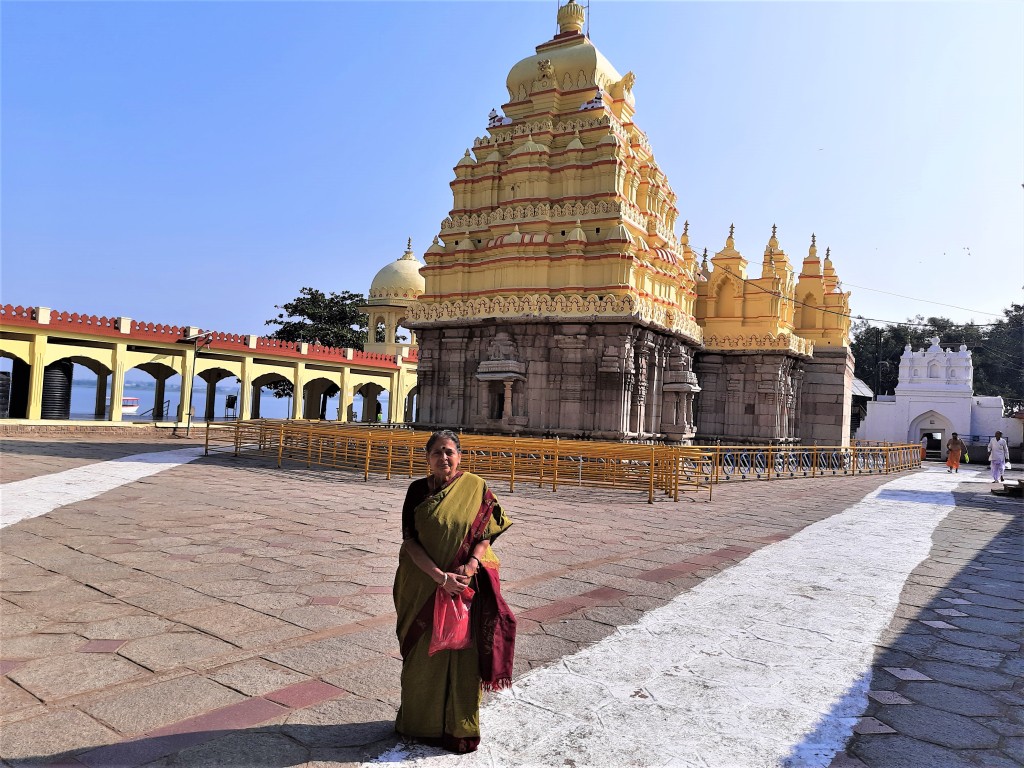
It is believed that in the 12th century Jathaveda Muni Sarangamath had set up an education centre here and Basaveshvara, Channabasavanna and Akkanagamma were students. Basaveshvara spent his boyhood here and, after his return from Kalyana, he is said to have become one with the God at this place. The vachanas composed by him are dedicated to the presiding deity here, Sangamanatha.
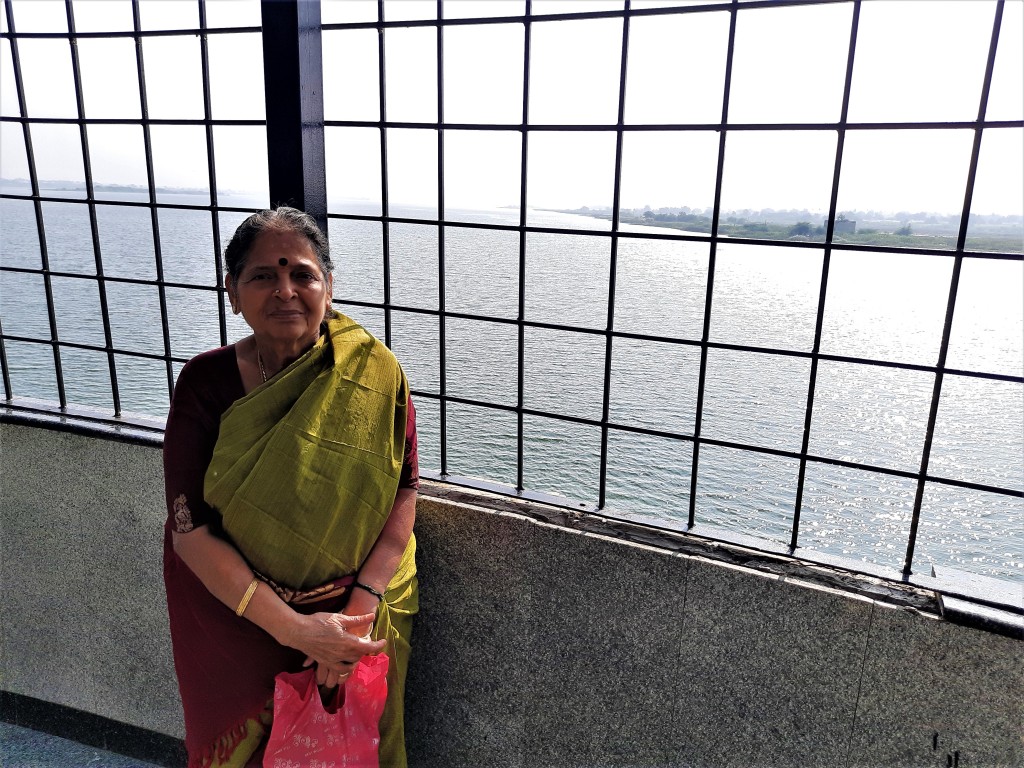
Vishwaguru (‘universal teacher’) Basavanna is the famous prophet and social reformer who was born in Bagewadi (Basavana Bagewadi), a small village in Bijapur District, in North Karnataka, also called Ingaleshwara Bagewadi. Agrahara was an important place in town. The house of Madiraja the chief of the township was situated here. Basavanna was a great saint; he is considered Guru by some and some believe in him as an incarnation of Nandi, Lord Shiva’s greatest devotee. A true visionary of his time and a revolutionary who started Lingayat sect. Basavanna’s ultimate aim was to make this fundamental right available to each and everyone. Basavanna, keeping welfare as the ultimate aim, expedited programmes to take religion to the people by preaching and writing religious literature in Kannada. His samadhi is at Kudalasangama.
Temple Timings: 5:00 AM to 12:30 PM, 4:00 PM to 8:00 PM
4.4 Shri Kanakachala Lakshmi Narasimha Temple
Shri Kanakachala Lakshmi Narasimha Temple, Kanakagiri Main Road, Kanakagiri, Karnataka 583283 Shri Kanakachala Lakshmi Narasimha Temple is located at Kanakagiri, Gangavathi taluk of Koppal district Karnataka at a distance of 21 Kms from Gangavathy. It is one of the 800 Narasimha temples in India.

Swarnagiri is the former name of Kanakagiri. Kanaka Muni performed penance here. The word Kanakagiri means “Hill of God”.Swarnagiri is believed to be headquarters of southern viceroyalty of Mauryas. This town has several ancient temples built by the Naiks of Kanakgiri. Of all the temples, Kanakachalapathi Gidu is the largest and known for its architectural beauty of Vijayanagara era.

Kanakachala Lakshmi Narasimha Temple also known as Kanakachalapathi temple is a 16th-century Hindu temple dedicated to the God Vishnu. The Kanakachalapathi temple is an example of Dravidian architecture of the Vijayanagara era. It is a protected monument under the Karnataka state division of the Archaeological Survey of India. The temple was built by the ruling vassal polyagar (Nayaka or feudal lord).
The temple complex is a large one with spacious halls (mantapa) and massive Yali pillars. There a three well executed tiered gopuras (tower over entrance) over as many entrances. Sculpture in the temple includes those of mythological figures in wood and pilaster, and that of kings and queens in black stone. The huge chariot in the temple known as Kanakaraya Ratha has 6 wheels and each wheel has 9 feet circumference.

Narasimha form of Bhagvan Vishnu and Goddess Lakshmi are separately worshipped in the temple. The combined form of Lakshmi and Narasimha worshipped in the temple is in Shaligram form.
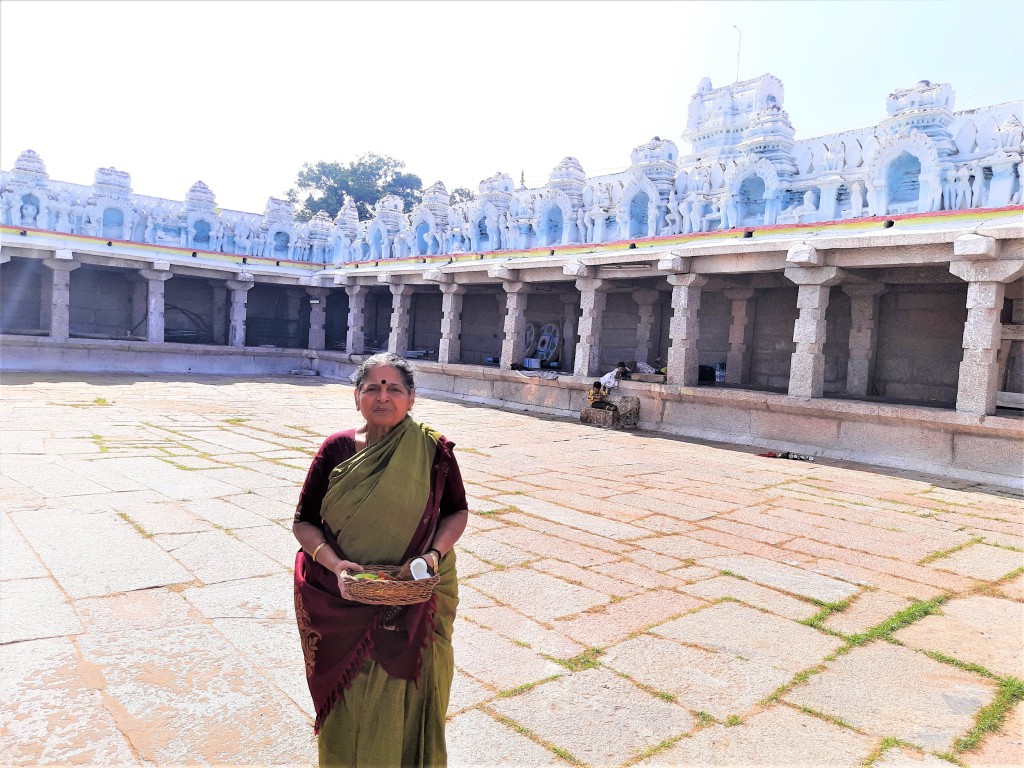
The popularity of the temple is supported by a local saying: “people with eyes must see Kanakagiri and those with legs, Hampi”, an affirmation that the Kanakachalapathi temple is a delight to the eyes where as one needs to tread tirelessly to enjoy the architectural wonders of near by Hampi (UNESCO World heritage cite), the royal centre of Vijayanagara, the capital of the Vijayanagara empire. In the months of February and March, during the Phalguna season, the temple hosts a popular fair called the “Kanakachalapathi fair”
4.5.1 Neelakanteshwara Temple, Gangavathi
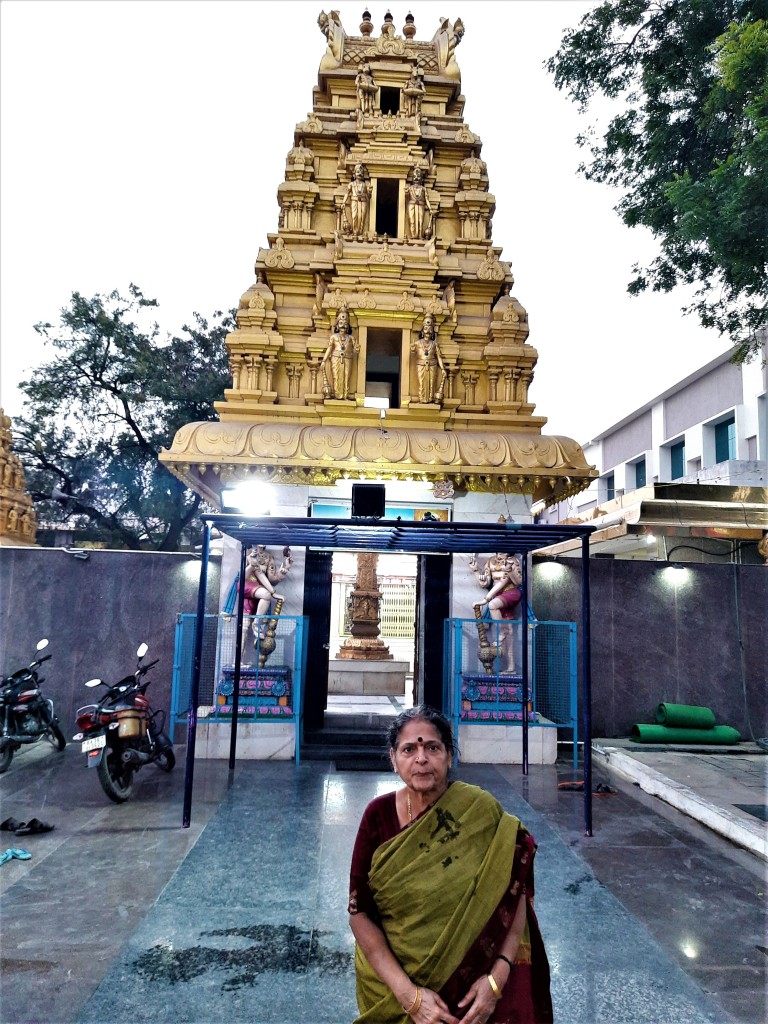
Neelakanteshwara Temple, CGGJ+6VC, neelakanteshwara camp, Gangavathi, Karnataka 583227 Neelakanteshwara Temple,is located at the center of Gangavathi town, Karnataka .It is close to the busy shopping areas of town. However inside the temple, it is quitge calm and serene.The temple is dedicated to Lord Shiva and the temple seems to be of recent origin.. There is a marriage hall in the temple facilitating marriages / reception
4.5.2 Nagareshwara Temple, Gangavathi

Nagareshwara Temple, Pathanwadi, 2-ward, Vidya Nagar, Gangavathi, Karnataka 583227 Nagareshwara Templeis located at the heart of Gangavathi town, Karnataka .It is of rfecent origin – 100 years old temple. It is dedicated to Lord Shiva. It houses Ganesa, Lakshmi Narasimha, Nagareswara , Parvati and Subhramanya Idols. It is a small and compact temple of the Gangavathy town.
4.5.3 Venkataramana Temple, Gangavathi
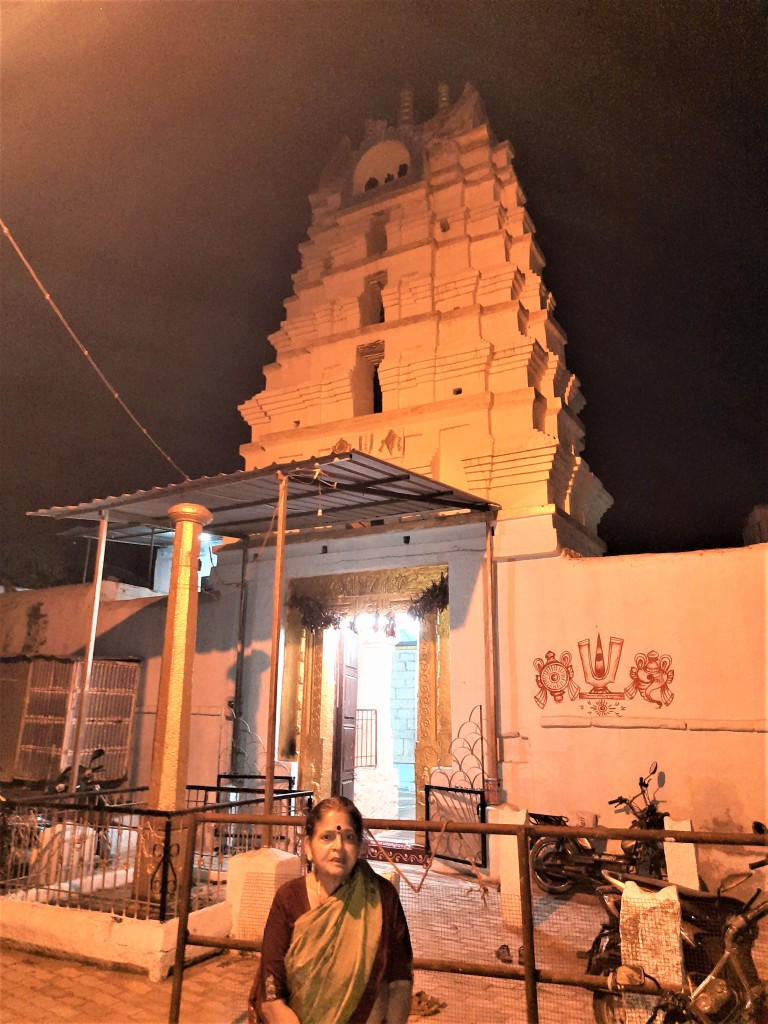
Venkataramana Temple, Gangavathi Rd, Killa Area, Vidya Nagar, Gangavathi, Karnataka 583227 Venkataramana Temple is located at the heart of ,Gangavath towni, Karnataka. This temple is 600 years old. The temple houses Lord Venkataramana – those who are not able to go to Tirupathi can have darshan here. Poojas and festivals are being conducted regularly. When we went, we witnessed Venkataramana swamy being taken around the temple in palankeen (doli)
5 Day 7
On Day 7, had darshan of Gandi Narasimhaswamy Temple, Kumarswamy temple, Sandur – believed to be the first abode in south India of Lord Subhramanya built by Rashtrakutas and adjacent Parvathy temple, built by Rashtrakutas. Then visited Bommaghatta Anjaneya swami Temple followed by Chalukya Temples at Ambli , Bagali and . Neelagunda and Hoysala temple at Harihara. Details of the temples are given below
5.1 Gandi Narasimhaswamy Temple, Swamymalai Block
Gandi Narasimhaswamy Temple, Kudligi Rd, Swamymalai Block, Karnataka 583124 Gandi Narasimhaswamy Temple is located at Swamymalai Block, Sandur Karnataka at a distance of 80 Kms from Gangavathy. It is one of the 800 + Narasimhar temples in India.

In ancient times, Sage Agasthya had done tapas in this Gandi Kshetra. A big fire / heat .was noticed which scared all living in the area, animals and Agasthya Rishi’s disciples. Everyone approached the Sage to solve the problem. The sage by his divine power (Gnana dhrishti) came to this cave in the hillock.
There was bright light and heat in the cave and no one could go inside. Sage Agasthya goes inside , offers prayers to Lord Narasimha. Pleased by his devotion, Lord Narasimha gives darshan to him. For the benefit of the devotees, the sage requests the Lord to appear in Santha swaroopam (peaceful appearance) instead of Ugra swaroopam.
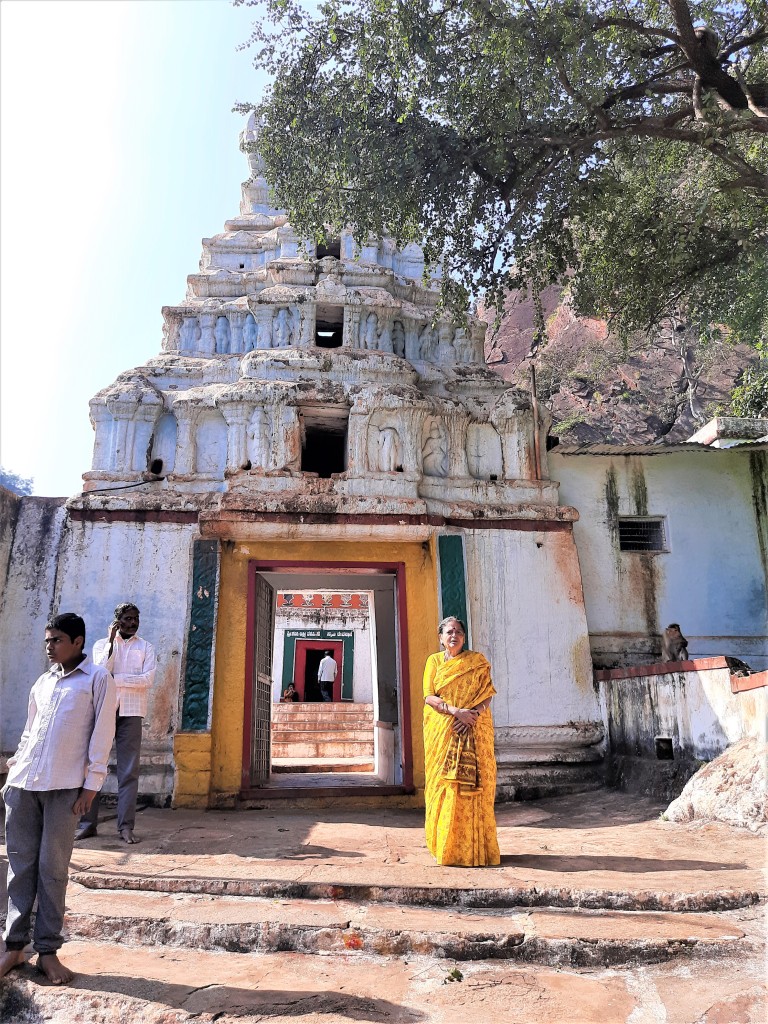
Lord Narasimha was in a dilemma. Devas prayers is to be in Ugra swaroopam – sage requests Santha swaroopam. To satisfy both, Lord said that He will recide in Ugra roopam beneath the pedastal and appear to devotees in Santha swaroopam in the form of a Crown (Kireetam). Hence in Gandi Kshetram we can see the crown with Narasimha face instead of customary idol.
Ganga devi wanted to have dashan of the Lord here – but she could not come up because of the hill cliff. Pleased with her prayers, Lord Narasimha says to give some offering to Him. Gangadevi offers to come there in the form of a small Rivulet instead of her full fury.She comes in 2 parts of rivulet. Sage Agasthya named her as Manasa Sarovar – since Gangadevi had done pooja with her heart / mind. One can see the river streams from the temple.
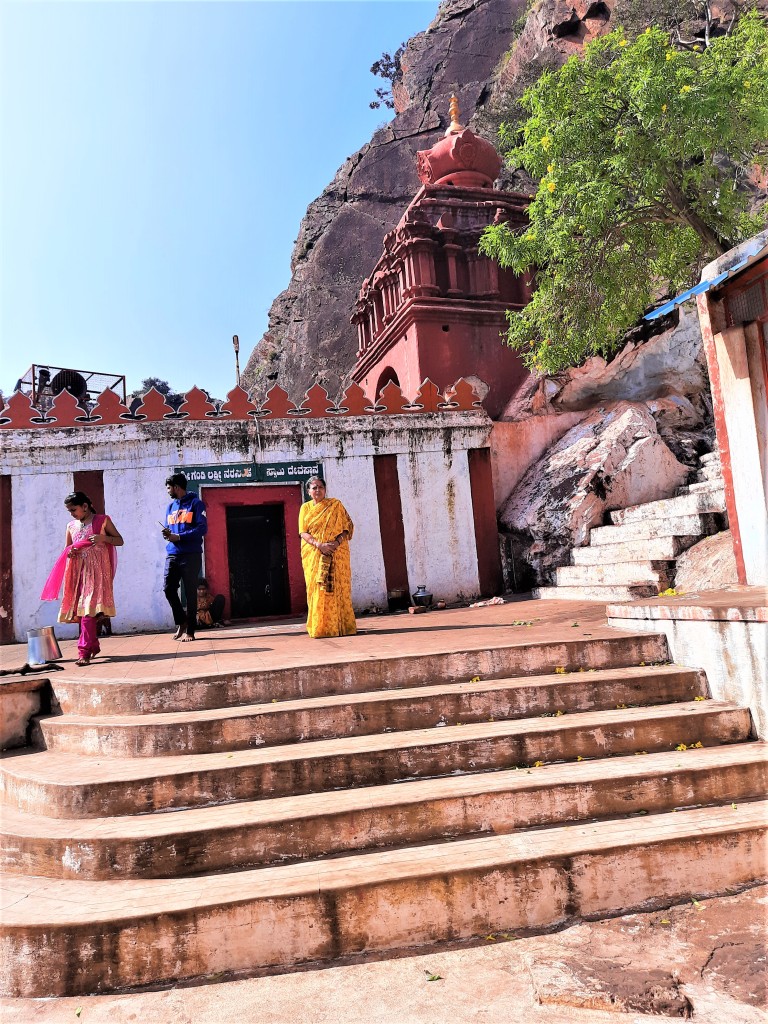
Lord also directed Laksmi idol to be installed- to retrive the same from a small well nearby – which is installed in the cave temple.. The highlights of cave temple are : 1) Lord Narasimha is in Ugra swaroopam form (beneath the pedastal) as well as Shanta swaroopa form (Crown) 2) Sage Agasthya had done penance here 3) Divine Ganga river is present in rivulet form. So this kshetra is very divine.
This is an ancient cave temple situated on the edge of a hill. One has to climb a set of stairs to reach the temple. The ancient cave temple has a pradakshina (circular) path accessible through a flight of steps which is easy to climb.

A tall gorge formed by Narihalla river is a short walk down from the car parking area. A serene place. Besides the shrine, the place is a picturesque spot. Close to the temple, a stream flows which cuts through a massive rock formation. This spot was one of the locations of “Manasa Sarovara” cinema. Contact : Gururaja Achar Mobile : 8762292046
5.2 Kumarswamy Temple, Sandur
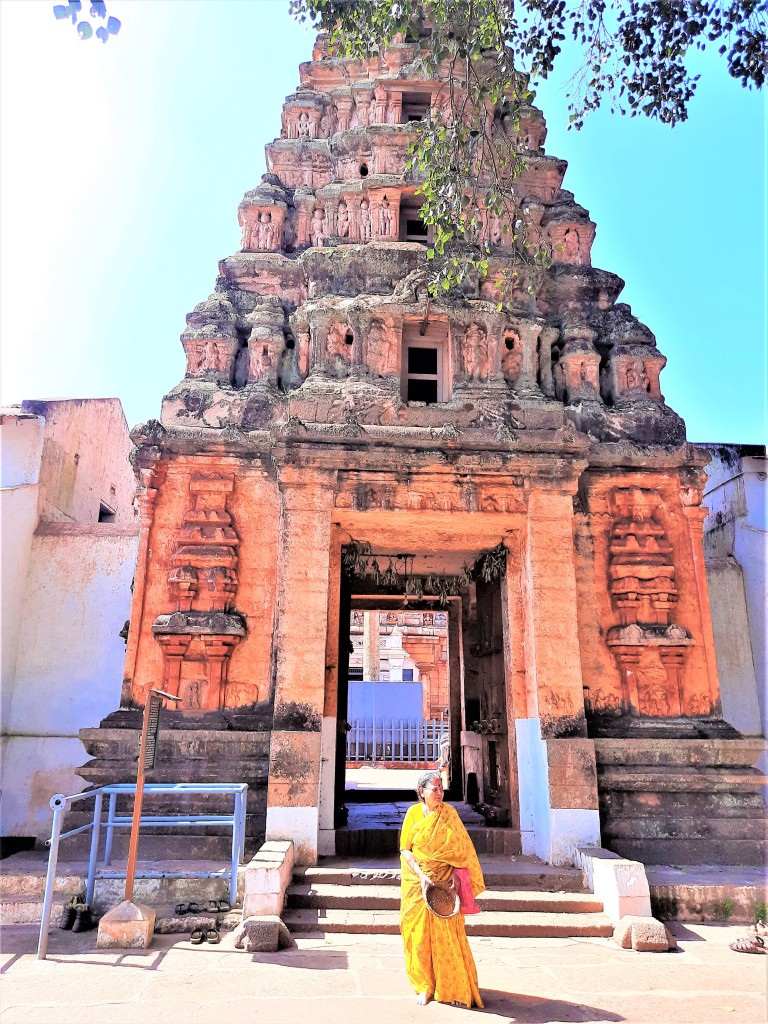
SHRI KUMARASWAMY TEMPLE, Kumarswamy Gudda, Sandur, Karnataka 583119 SHRI KUMARASWAMY TEMPLE is located within the Swamimalai forest range of the Krauncha Giri (hill) at Kumarswamy Gudda, Sandur, Bellary distric, Karnataka at a distance of 86 kms from Gangavathy.This temple is believed to be the first abode in south India of Subhramanya /Kumaraswamt/ Murugan. This is one of the 1000 Murugan temples .
According to the Legend, the Parvati temple was built by the Badami Chalukyas during the 7th to 8th century AD. This shrine has a vigraha of Goddess Parvati who is the main deity. This temple is a part of the Kumaraswamy temple (originally had Shanmukha as the main deity) which was built by the Rashtrakutas during the 8th-10th century AD. Both the parvathi temple as well as the Karthikeya temple stands as protected monuments of India under ASI. The temple was discovered later in the 15th century by the local rulers called the Ghorpades, from the dense forests of Swamimale hill.

The image of the deity is made of black stone who is holding a club in his hand and beside him stands his vehicle, the peacock. To art historians, the Parvati Temple located nearby (7th-8th century) is more unusual in terms of Hindu temple architecture. There are fine figures of divinities in temple and many well-executed images placed on pedestals in the interior of this temple.
A distinctive feature of the mountain is its elliptical shape with a diametric narrow pass. According to legend, this gap is made when Kartikeya pierced the mountain in the battle with the demon Tharaka, with his sphere weapon vel to kill the demons who were hidden inside mountain. This legend is held in high esteem in Hindu mythologies including Mahabharata (salya parva. 46), Skanda Purana (asura kandam). Krauncha Giri is also associated with legends of the sages Agastya and Parasuram.
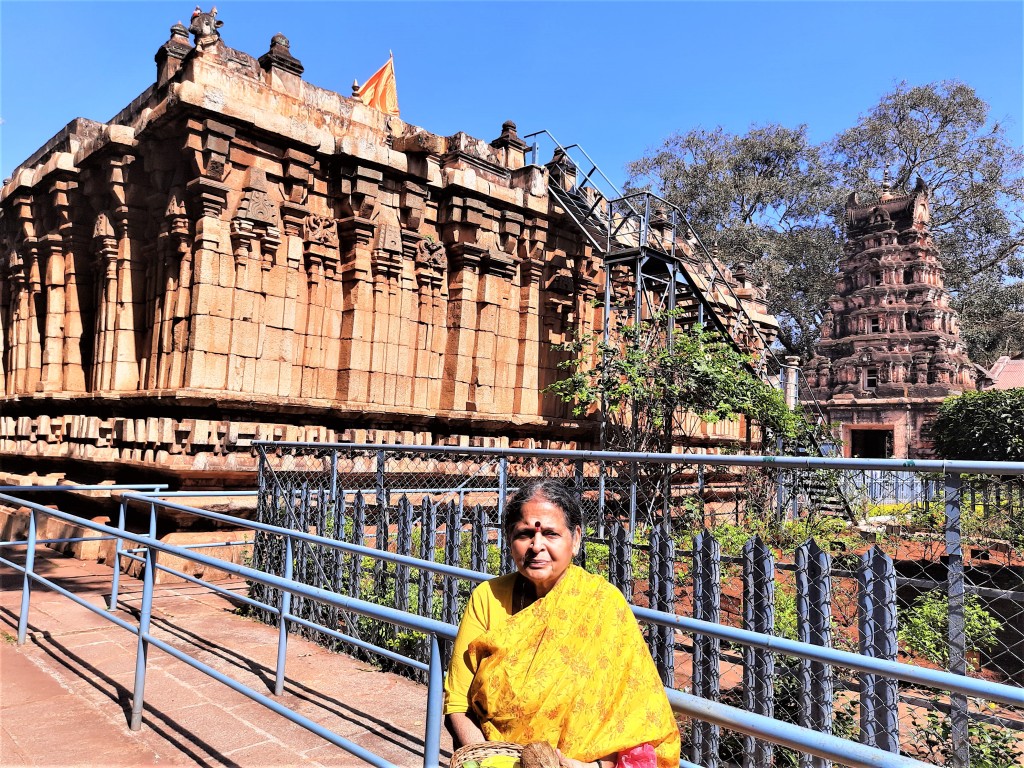
Kalidasa in his work Megha Sandesa describes the gap in the mountain. This place is connected with legends of Sri Sailam jyotirlinga in Andhra Pradesh. The name ‘Krauncha Giri’ is very familiar to many, but few know the location of this legendary mountain. For many, it’s just a mythical one like Mount Meru.
5.3 Parvathy temple, Kumarswamy Gudda,Sandur
Parvathy temple, Kumarswamy Gudda, 2H56+W72, Sandur, Karnataka 583119 Parvathy temple is located within the Swamimalai forest range of the Krauncha Giri (hill) at Kumarswamy Gudda, Sandur, Bellary distric, Karnataka at a distance of 86 kms from Gangavathy.
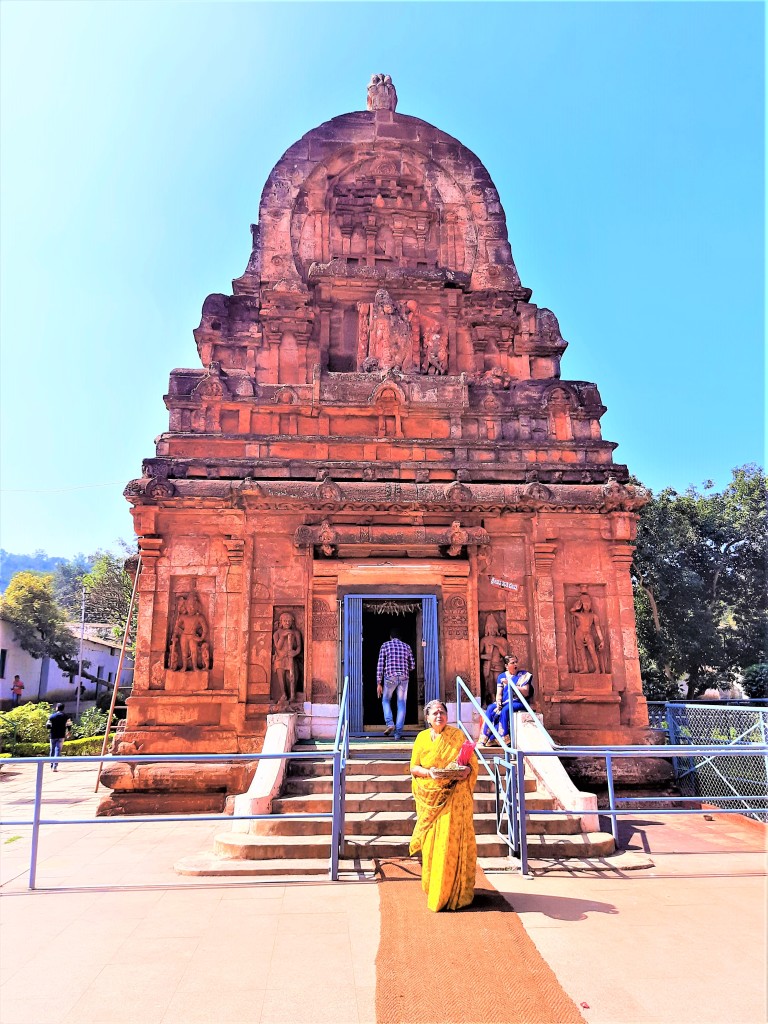
Sandur is about 30 km by road from Hospet, and the Parvati Temple (in what is known as the Kumaraswamy Temple complex) is a further 10 km ahead. Sandur is surrounded by the Sandur Hills, famous for their extensive iron and manganese ore mining. The temple site is near the top of one of these hills, known as Krauncha Giri.The Parvati Temple has a unique longish barrel-vaulted antaralay leading to a square shrine with horizontally layered viman/tower. Kumaraswamy Temple (without its original viman/tower) adjacent to the Parvati Temple, is of later vintage (possibly around the 10th century.
Kumaraswamy temple is believed to be the first abode in south India of Subhramanya /Kumaraswamt/ Murugan. This is one of the 1000 Murugan temples .To art historians the Parvati Temple beside it (7th-8th century) is the more unusual in terms of Hindu temple architecture.

According to the Legend, the Parvati temple was built by the Badami Chalukyas during the 7th to 8th century AD. This shrine has a vigraha of Goddess Parvati who is the main deity. This temple is a part of the Kumaraswamy temple (originally had Shanmukha as the main deity) which was built by the Rashtrakutas during the 8th-10th century AD. Both the parvathi temple as well as the Karthikeya temple stands as protected monuments of India under ASI. The temple was discovered later in the 15th century by the local rulers called the Ghorpades, from the dense forests of Swamimale hill.
Parvathy temple, has beautiful Maha Vishnu , Surya Narayan, Yama Dharma Raja and Krishna Idols
5.4 Bommaghatta Anjaneya swami Temple
Bommaghatta Anjaneya swami Temple, ಕೆರೆ (Lake, Bommaghatta, Karnataka 583128 Bommaghatta Anjaneya swami Temple is located at Bommaghatta, Karnataka at a distance of 100 kms from Gangavathy., 80 km from Bellary, 23 km from Kudligi and 55 km from Hampi.
Bommghatta Hanuman Temple is popularly known as Hulikunteraya or Hulikunteswamy Temple. This ancient shrine is dedicated to Ram Bhakt Hanuman. As per the Legend the murti of Hanuman worshipped in temple was discovered by a cowherd, named Bommaiah, in a grass bush. As the murti was found under the bush of grass on the banks of a water tank, the murti has been named as Hulikunteswamy.

It is said that the murti was hidden in a grass for long time. Then a divine cow and calf joined among the cows of a cowherd. The cow started giving large quantity of milk. But one day it started giving milk. The cowherd then noticed that the cow was shedding her milk near a bush. When the cow realized that the cowherd had seen her shedding milk it disappeared. The cowherd then checked the area and found the divine murti of Hanuman.
Sri Prana Devaru was seen with the raised right hand as if giving blow to the ravanathis and at the same time it is seen giving blessings to all His devotees. His raised langoola bestows on us courage and vigour. Sri Prana Devaru is holding gadha like Bhima. His tuft is seen like that of HH Sri Madwacharya. On the top of the shila is a inscription of Surya and Chandra indicating the link with Sri Janamejaya. A rakshasa representing evil force is seen crushed under His noble feet.
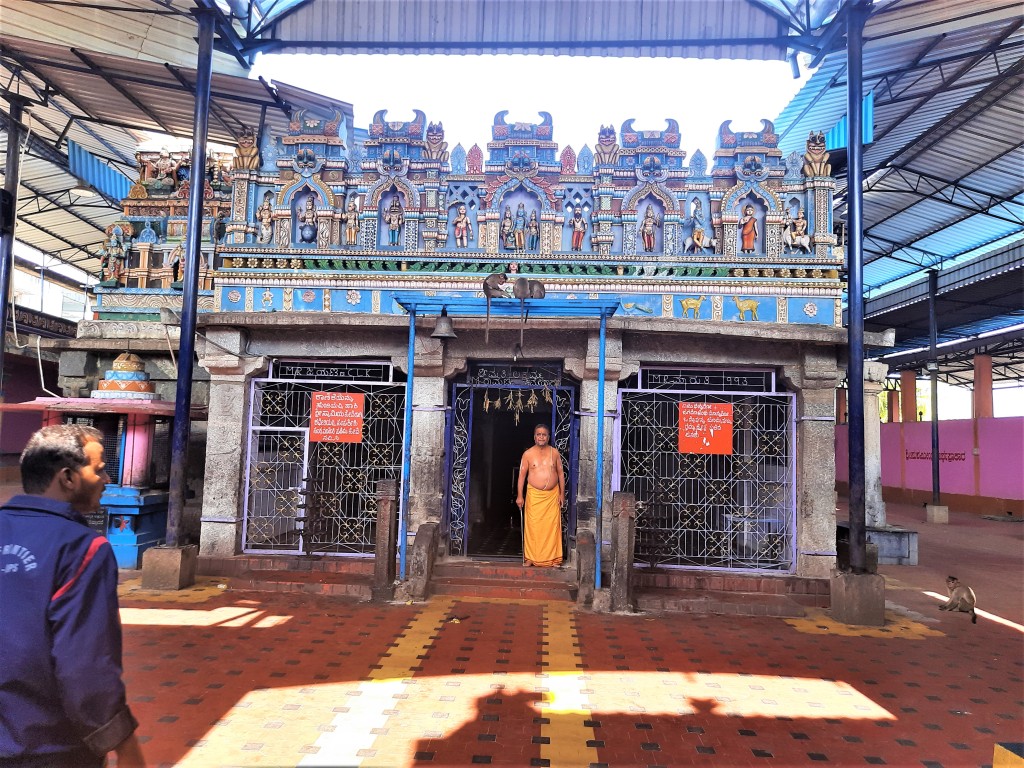
It was felt by the village elders that the moorthy which was in worship, had been out of sight for the reason better known to Sri Prana Devaru. It was decided to place the moorthy in a proper place in the village and start the discontinued poojas as per the laid rules.
Next day morning the villagers decided to take the moorthy to the village and make pratistapana. They had made a chariot for taking the moorthy in procession to the village. They placed the moorthy decorated with flowers on the chariot and started pulling the chariot. But the chariot stopped moving after about five hundred feet. Their efforts to move the chariot proved futile. On the same night one of the village elders was given a divine direction to the effect that the moorthy should be installed in the same place where the chariot had stopped.
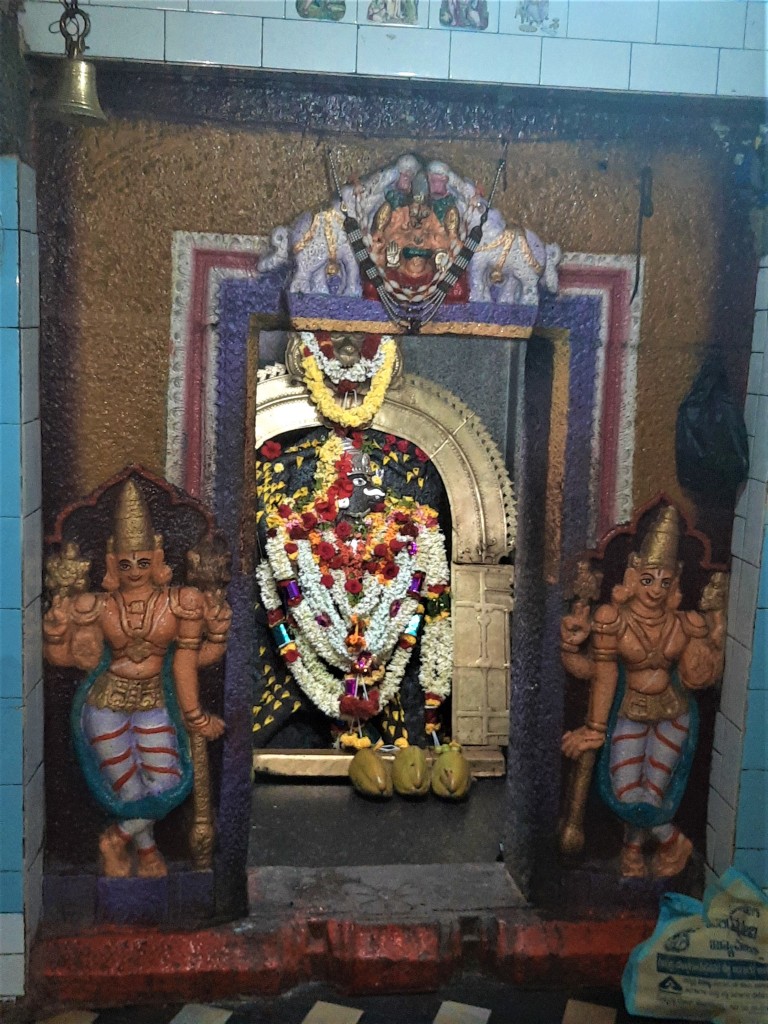
Accordingly the Sri Prana Devaru moorthy was kept in the very same spot and the regular poojas were conducted by Huliappan. Since the swayam vyektha moorthy of Sri Prana Devaru was found in the bushes of the plant name ‘Hooli podhe’, Sri Prana Devaru of the kshetra is known as Sri Hulikuntesha swamy (Sri Hulikunteraya).
Sri Vyasaraja TirthaHH Sri Vyasaraja who had visited this village, was told about the Sri Prana Devaru moorthy. HH decided to stay for the Chaturmasya vritha in the village and made prana pratistapana of Sri Mukya Prana and a garbhagraha was also constructed. Then on the regular poojas were conducted for Sri Mukya Prana installed by HH Sri Vyasaraja.
There are murtis of Shiva, Sri Rama, Sita, Lakshmana, Anjaneya and Garuda in the temple. The most important temple in the temple is held from Phalgun Shukla Paksha Panchami to Dwadasi
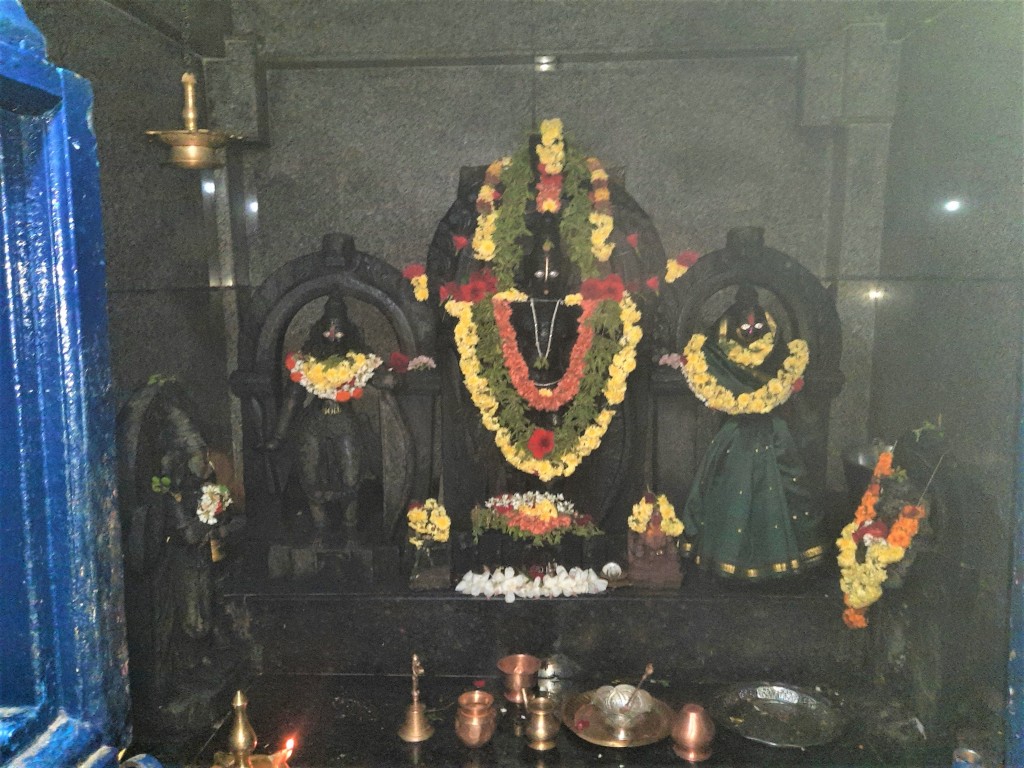
In the east of the temple the villagers wanted to build a tank for holy water [pushkarani] for i Prana Devaru. Once they started digging the land for the tank they found some treasure there and with that money they built the pushkarani. While HH Vadiraja was on a pilgrimage to this kshetra found a rudra moorthy in the pushkarani [holy tank] of the temple. HH Sri Vadiraja had installed the moorthy on the bank of the tank and named it Sri Gangadhara.
In the year 1807 Sri Subodhendra Theertharu dissentant of Sri Raghavendra Swamy did the pratistapana of Sri Seetha Lakshmana Hanuman Garuda presided by Sri Rama Devaru. It is said that these moorthys were given by Nanjangodu Sri Rama Sastri.Sri Sushameendra Theertharu of Sri Sri Raghavendra mutt had made pratistapana of navagrahas in the temple. Bommghatta Hanuman Temple Opening and Closing Time:: 6:00 AM to 1:00 PM 4:00 PM to 7:00 PM
5.5 Kalleshwara Ancient Temple, Ambli
Kalleshwara Ancient Temple, W52G+WGM, Ambli, Karnataka 583134 Kalleshwara Ancient Temple,is located at , Ambli, Karnataka at a distance of 70 Kms from Davangere.
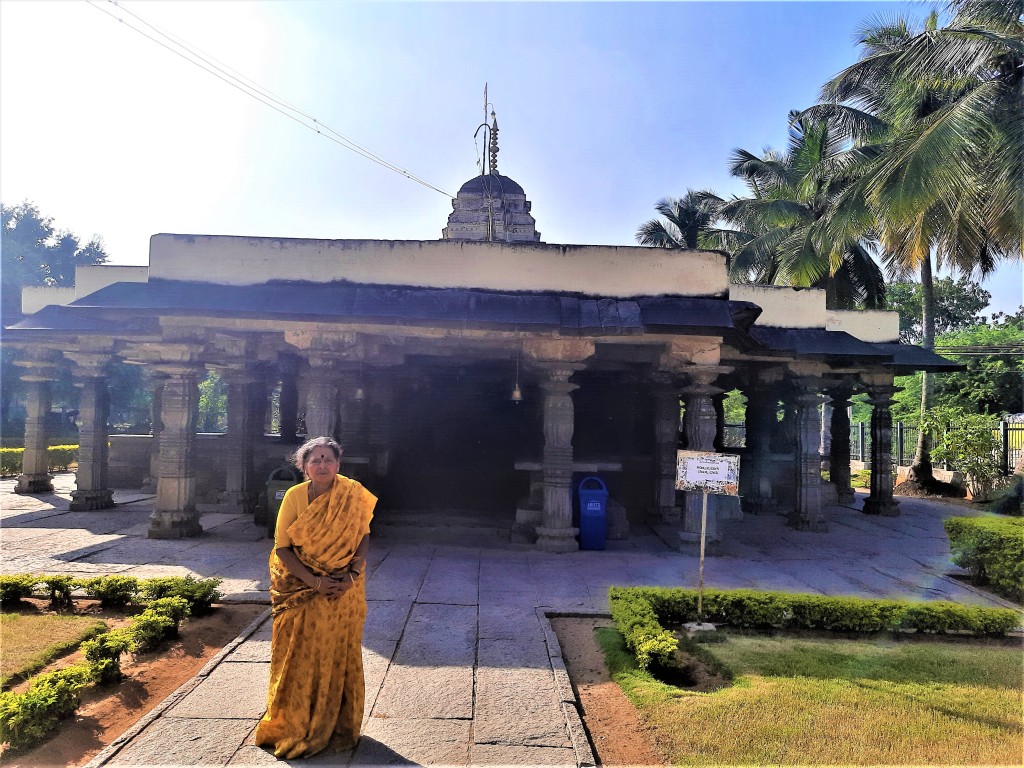
In the Kalleshvara temple, as per an Old Kannada inscription (dated 1083) placed in the sabhamantapa (lit, “gathering hall”), the temple was constructed during the reign of the Western Chalukya Empire King Vikramaditya VI (also called Tribhuvana Malla) This temple is protected as a monument of national importance by the Archaeological Survey of India.
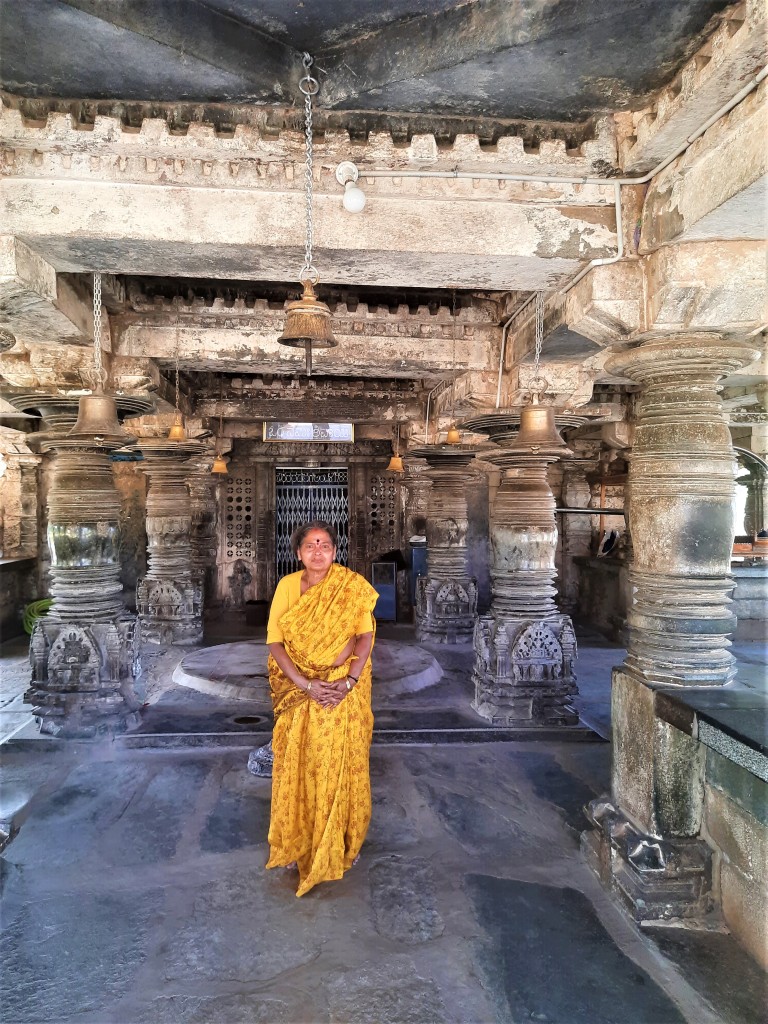
The architectural style of the temple is 12th century, trans-Tungabhadra branch of the Lakkundi school, related to Kuruvatti (Mallikarjuna temple) with some non-mainstream affinities . The temple is a single shrine (vimana) construction with an adjoining hall (mantapa). The basic building material is Soap stone. The original superstructure over the shrine is lost. The temple faces east comprises a sanctum (garbhagriha), an antechamber (or vestibule or antarala whose tower is called the sukhanasi) that connects the sanctum to a gathering hall (sabhamantapa) which is preceded by a main hall (mukha mantapa)
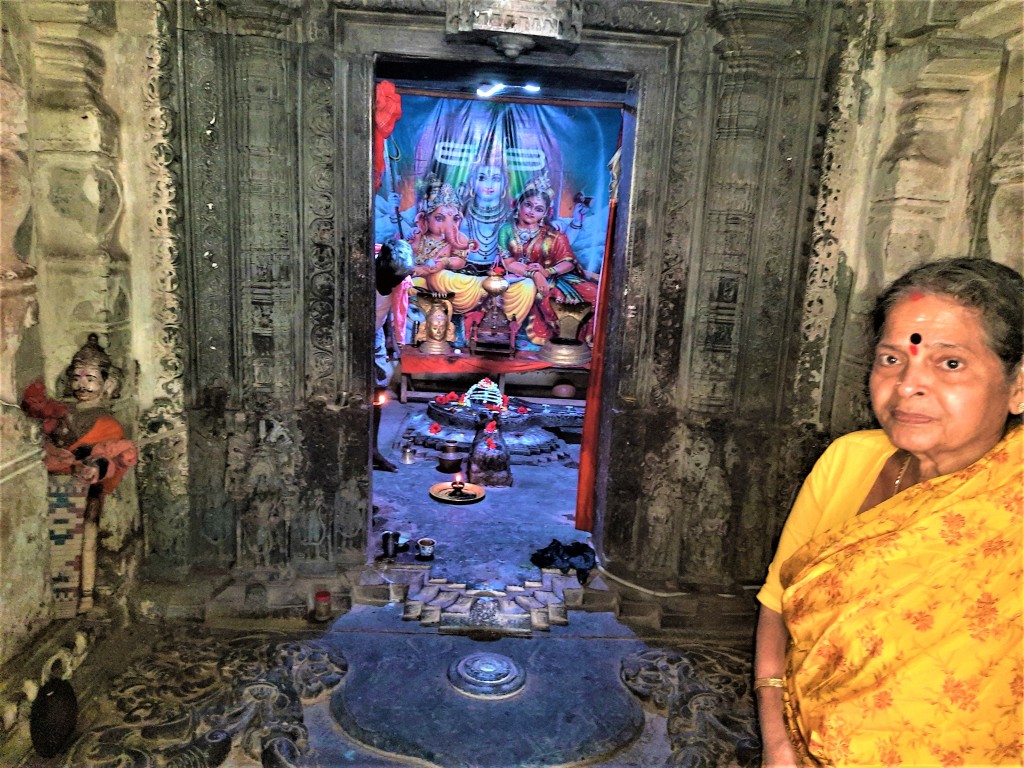
The square bases of pillars in the Sabha Mandapam and Mukha Mandapam have the characteristic decoration with reliefs, depicting various Hindu deities such as Surya (the sun god), Bhairava ,Shiva and Durga. The Garbariha (sanctmsanctorm) hoses a Shiva linga and has an ornate pancha(five)shaka (jamb) door frame decorated with lozenges, creepers, musicians, dancers, birds, lions and elephants. The door jambs have Dwarapalakas attended by Rati and Manmatha.

The lintel of the Garbagriha has a well sculpted Gajalakshmi with elephants on either side. The threshold ofthe door in front has a decorated moon-stone or semi-circular stone slab (chandrasila). The antarala doorway is intriguing with lozenge flower decorated perforated screens. The door jambs have sculptures of Dwarapalakas.The lintel of the antarala (sukhanasi / vestibule) has a beautiful carving of Nataraja (dancing Shiva) who is watched by goddess Parvati and attendants who include Lords Vishnu and his consort Lakshmi along with Lord Brahma and Goddess Saraswathi, and the Ashtadik-palakas (guardians of the eight cardinal directions).
The exterior walls of the sanctum houses mouldings or friezes consisting of a miniature lions (Simha),elephants and makaras with strings of pearl tassels in combination. There are three finely carved miniatureshikara on the three walls of the Garbagriha. The moulded adhisthana (basement or plinth) has indentationsup to the walls which resolve into manch-bandha pattern whose projections carry niches. These are treated with Dravida turrets raised on slender pilasters.
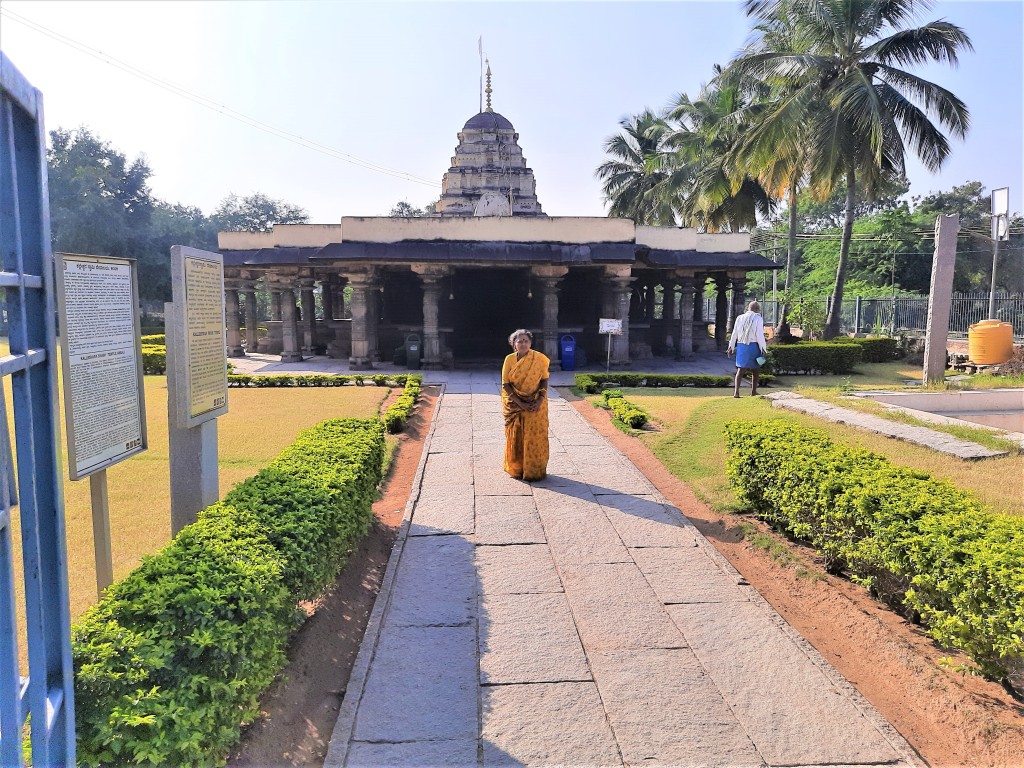
The turrets (vertical projecting towers) are crowned with Kirtimukha (glory-faced) makara torana. Theshikara above Garbagriha is comparatively plain and of Dravidian style. The natya-mandapam situated at thecenter has four lathe pillars with sculpted bases similar to the ones in many other Chalukyan temples
5.6 Kalleshwara Temple, Bagali
Kalleshwara Temple, RXXM+3VG, Bagali, Karnataka 583131 Kalleshwara Temple is located at Bagali, Karnataka at a distance of 50 kms from Davangere.
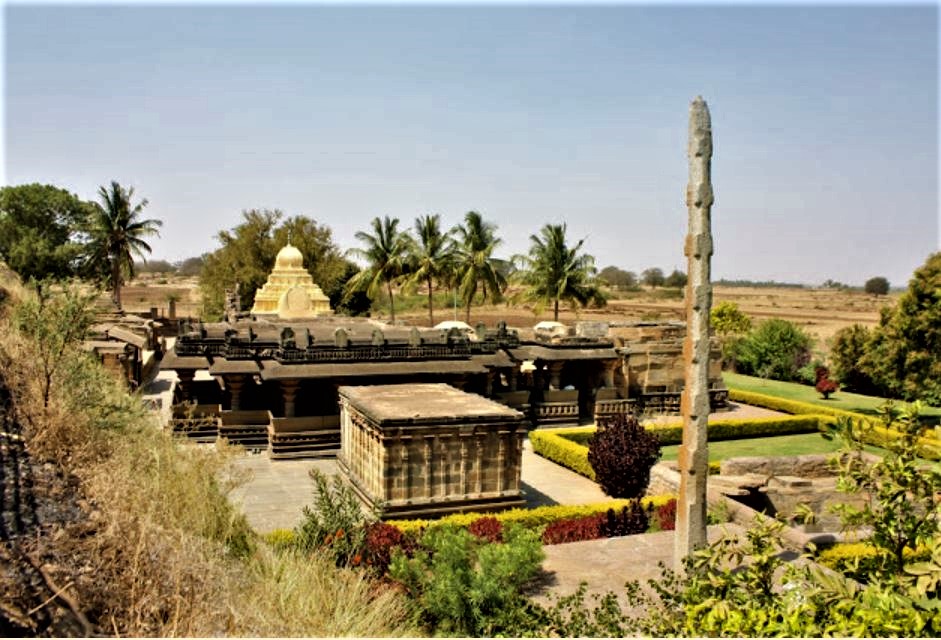
The Kalleshwara temple here is considered to be one of the rare temples of India. Unique in its style and appearance, it is popularly regarded as Karnataka’s Khajuraho. There are very few temples in India where the goddess and god of love (Rathi and Manmatha) are carved as Dwarapalakas. Here one can see the beautifully carved images of them guarding the temple. This temple was built during the 9th century AD by the Rashtrakutas which later underwent modifications under the reign of Chalukyas and the Hoysalas.
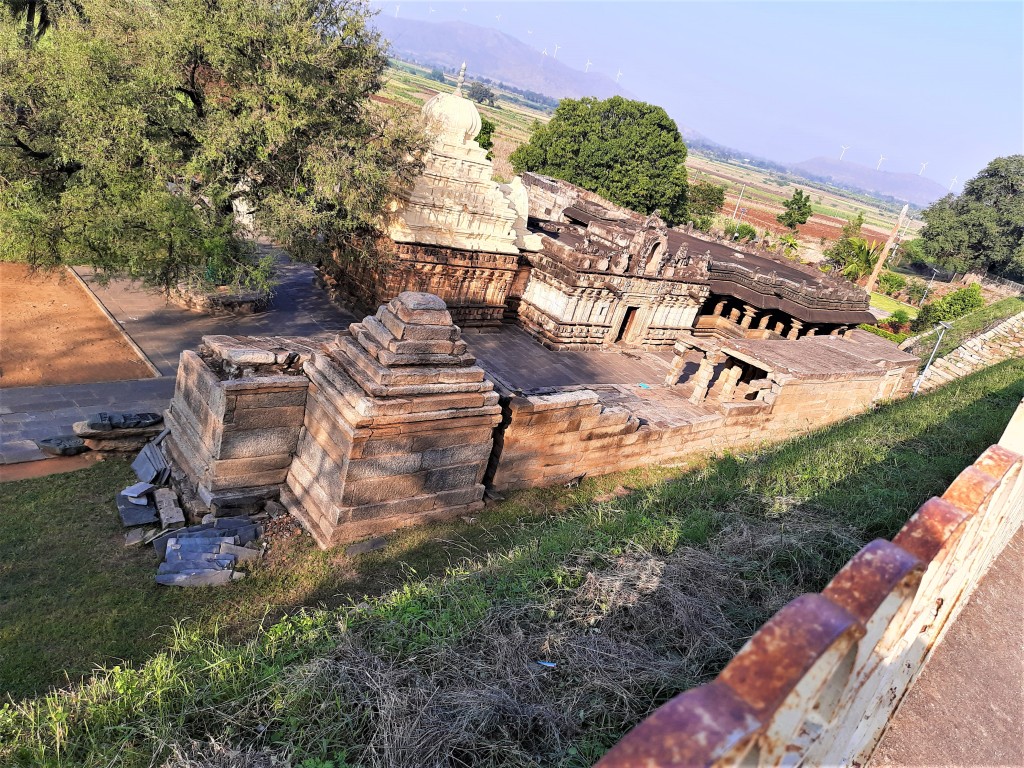
The construction of Kalleshvara temple spans the rule of two Kannada dynasties: the Rashtrakuta Dynasty during the mid-10th century, and the Western Chalukya Empire, during the reign of founding King Tailapa II (also called Ahava Malla) around 987 AD. (the dynasty is also called Later or Kalyani Chalukya).

Bagali is referred to as Baguli and was one of the capitals during the rule of Hoysala King Ballala II. However, to a large extent the credit of building this temple goes to the Western Chalukyan king Vikramaditya VI. The main temple of Kalleshwara is extensively carved and has been built to perfection. The open Sabha mantapa/ Natya mantapa of the temple has 59 exquisitely carved pillars and none are similar. The four central pillars are the most beautiful with the detailing on them being parallel to none. While the ceilings of the mantapa are beautifully carved, the door-jambs are very skillfully executed and go on to serve as the perfect examples of Chalukyan architecture.
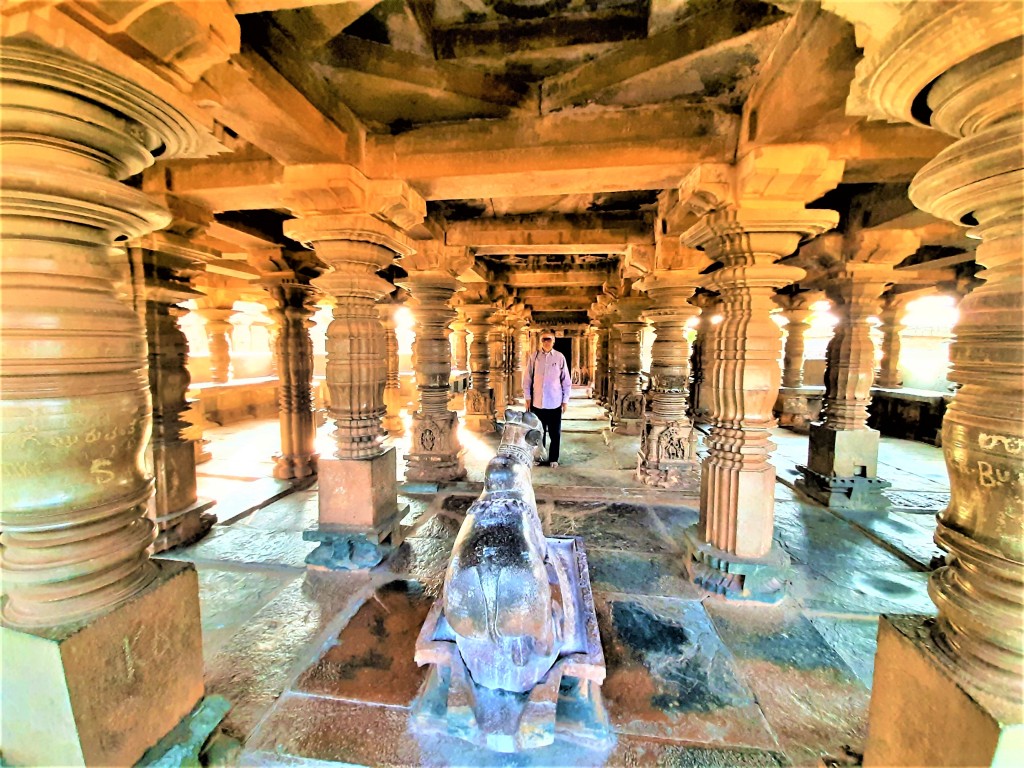
Lord Shiva in the form of a big Linga is worshiped here . Many small shrines dedicated to various gods are present around this temple. While major portion of the temple exteriors remain simple, the upper portion is adorned with reliefs of erotica. Though the erotic carvings beat that of Khajuraho in number (in depicting the various postures), they are far from being as perfect. With 62 carvings, it stands proudly as one housing the largest collection of erotica images. The prototypes of these images were taken to Paris for further examination as a part of study and are now a part of the Paris Museum.
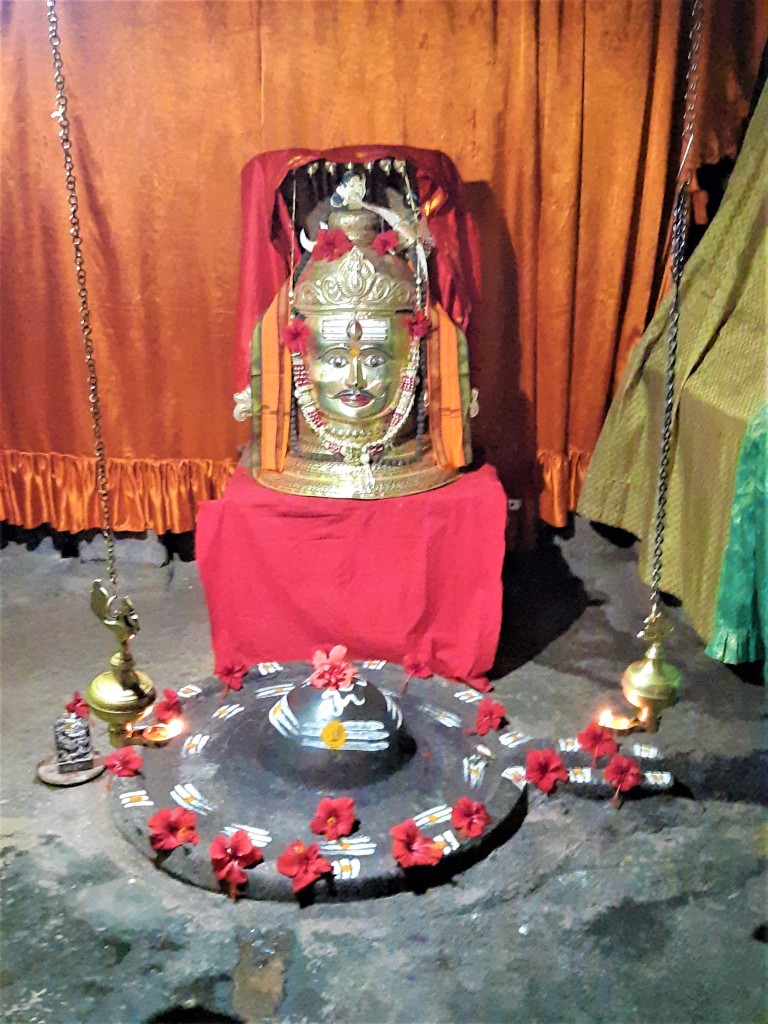
The temple plan comprises a main shrine for Lord Shiva with a sanctum (cella or garbhagriha) facing east, a vestibule (antechamber or antarala), a main closed hall (mahamantapa) with an entrance in the south and east. These structures are attributed to the 10th century Rashtrakuta rule. The closed hall is preceded by a large, open gathering hall (sabhamandapa) with fifty highly ornate lathe turned pillars that support a decorative ceiling.
Also provided are a shrine for the Sun god Surya with a hall (mukhamandapa) facing the east-west orientation, and a small shrine for the deity Narasimha (a form of the Hindu god Vishnu) in the north of the gathering hall. These constructions are ascribed to the Western Chalukya rule. In all, there are eight small shrines built around the main shrine. Of the fifty pillars, twenty four pillars are located over the platform (jagati) provided with a balcony seating (kakshasana).
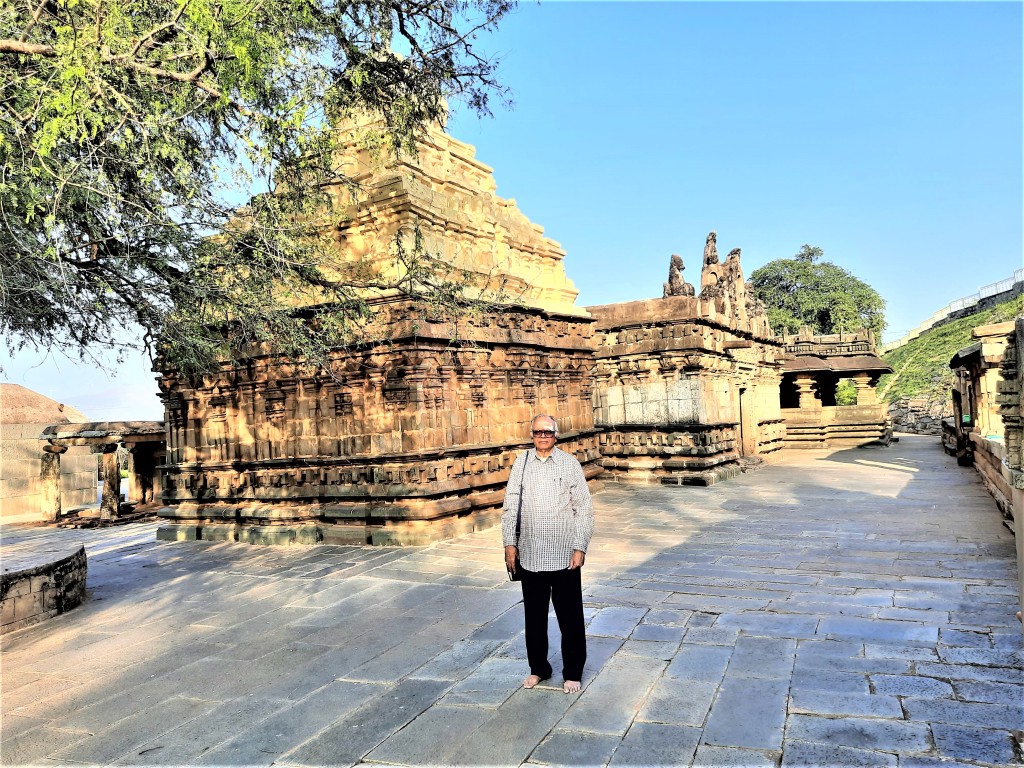
The door ways (doorjamb and lintel) of the eastern doorway that faces the Nandi and the southern doorway that forms an entry into the close hall are intricately decorated. A few independent sculptures from the late Chalukyan period are found in the closed hall. These include Shiva, Umamahesvara (Shiva with his consort Parvati), Ganesha, Kartikeya, Surya, Anantasayana (the god Vishnu seated on a snake), Sarasvati and Mahishamardini (a form of the goddess Durga). Must visit this excellent temple.
5.7 Bheemeshwar Temple. Neelagunda
Bheemeshwar Temple. ಶ್ರೀ ಭೀಮೇಶ್ವರ ದೇವಾಲಯ, PVVW+JGX, Neelagunda, Karnataka 583213 Bheemeshwar Temple. is located at Neelagunda, Karnataka at a distance of 45 kms from Davangere and 30 km from Harihar .
Nilagunda, known for its steatite (Soapstone) quarries, was an important village right from the times of Kalyana (Circa 12th Century).. Bheemeshwara Temple built by the Kalyani Chalukyas in the late 11th century in Vesara style.is on the outskirts of Nilagunda village, set on the tank bund. . The east facing temple is constructed in tri-kuta style having three garbha-grihas (sanctums), one each on the west, the north and the south. All three have their own antarala (vestibule) and share a common closed sabha-mantapa (pillared audience hall). A mukha-mantapa (front pillared porch) is attached to this sabha-mantapa. A shrine dedicated to Surya (sun god) is attached to the mukha-mantapa on the east. Only the central shrine has a Vimana (tower). The tower is an amalgamation of different styles. It is mainly built in the Vesara style however the stupa at the top is square in shape which puts it under the Nagara style.
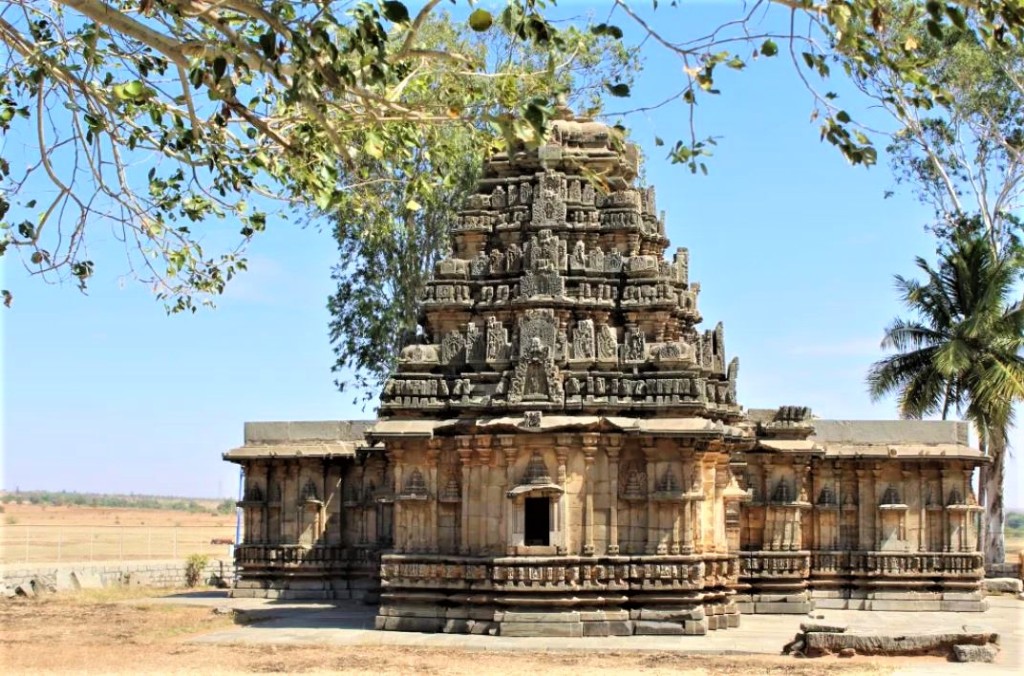
While the northern and southern shrines are bereft of idols, the western garbha-griha houses a linga representing Shiva and the deity is Bheemeshwara. Its doorway has Gaja-Lakshmi as the centre piece of the lintel and dvarpalas (door keepers) at the jambs. The antarala (vestibule) doorway is profusely carved with dvarpalas at its jambs. The makaratorana (lintel flanked by mythical creatures) has an exquisite representation of the Hindu Trinity, Shiva with Parvati, Ganesha and Kartikeya are in the middle, Brahma with Saraswati on the left and Vishnu with Lakshmi on the right.

There’s an intricately carved Gaja-Lakshmi again as the centrepiece of the doorway just below the makarathorana. There are also four subsidiary shrines around the western garbha-griha in the sabha-mantapa. The roof of the sabha-mantapa is simple yet well carved. A large idol lies resting against one of the pillars of the sabha-mantapa. It depicts Narayana in a seated position with Lakshmi seated on the folded leg. The posture is intimate with one hand of Narayana curved around Lakshmi and holding her. Unfortunately some of the projecting hands have been vandalised. Most likely, the idol was brought here from another temple.
While the northern and southern shrines are bereft of idols, the western garbha-griha houses a linga representing Shiva and the deity is known as Bheemeshwara. Its doorway has Gaja-Lakshmi as the centre piece of the lintel and dvarpalas (door keepers) at the jambs. The antarala (vestibule) doorway is profusely carved with dvarpalas at its jambs. The makaratorana (lintel flanked by mythical creatures) has an exquisite representation of the Hindu Trinity, Shiva with Parvati, Ganesha and Kartikeya are in the middle, Brahma with Saraswati on the left and Vishnu with Lakshmi on the right.

There’s an intricately carved Gaja-Lakshmi again as the centrepiece of the doorway just below the makarathorana. There are also four subsidiary shrines around the western garbha-griha in the sabha-mantapa. The roof of the sabha-mantapa is simple yet well carved. A large idol lies resting against one of the pillars of the sabha-mantapa. It depicts Narayana in a seated position with Lakshmi seated on the folded leg. The posture is intimate with one hand of Narayana curved around Lakshmi and holding her. Unfortunately some of the projecting hands have been vandalised. Most likely, the idol was brought here from another temple.
The outer walls have niches with repetitive designs. There are a few sculptures of gods which have been ravaged by wind and water. The Ugra Narasimha is noteworthy. The Vimana is well decorated with kirti-mukha motifs and sculptures of Brahma, Vishnu and Maheshwara in various forms. Overall, the temple seems like it was finshed off in a hurry because the main doorway to the sabha-mantapa is bereft of any ornamentation in contrast to the other doorways and the outer walls have some plain niches prepared for carving.
The temple is set on the scenic lake and worth visiting.
5.8 Hari Hareshwara Temple, Harihara
Hari Hareshwara Temple, Harihara, harihareshwara temple, taluk, Fort, Gandhi Nagar, Harihar, Karnataka 577601 Hari Hareshwara Temple is an ancient temple located in the heart of Harihar town, Karnataka and is at a distance of 275 Km from Bangalore, 131 Km from Hubli and 14 Km from Davangere.
This wonderful temple’s main deity is a union of Gods Vishnu and Shiva.. The temple is also known as God’s Own House. The hills of Harihareshwar, Pushpadri, Harishinachal and Bramhadri surround this place. Harihareshwar also boasts of clean and pristine sandy beaches. The place is also gaining importance as a popular tourist destination. The attributes of Shiva are visible in the right hand and Vishnu in the left hand.

As per the legend, the demon Guha appeased the creator of the universe and got a boon by which neither Shiva (Hara) nor Vishnu (Hari) could destroy him single handedly. Guha started torturing the gods in Indralok as well as human beings in the prithvilok and it became difficult for everyone to withstand his devastation. As both Shiva and Hari could not destroy him on their own, they had to unite and take the form of Harihara to destroy Guha. It is said that this incarnation took place close to Kudalore where the rivers Haridra and Tungabhadra meet.
The Harihareshwara temple built in 1223–1224 by Polalva, a commander and minister of the Hoysala Empire King Vira Narasimha II is situated in Harihar / Harihara, Karnataka dedicated to Hari-hara / Lord Vishnu-Shiva. The beautiful 4 feet height idol is a powerful combination of the protector (Hara / Lord Vishnu) and the destroyer (Lord Shiva). The deity is also known as Shankarnarayana and Sambhu-Vishnu.This place is also known as Dakshina Kashi / Southern Kashi. On the right side of Harihara idol is carved Shiva’s trishul and the hair styled as an ascetic and on the left side Vishnu is carved with the discus and head is covered with a crown. This marvelous stone carved temple is visited by both Vaishnavaites and Shaivites.

The architecture in the Harihareshwara temple resembles that normally used by the Hoysala dynasty. The mantapa or hall as it is called is square in shape. The pillars and the ceiling have exclusive architecture and decoration like lotuses. The Hoysalas used soapstone for building the temple. There is a lot of repair work which is being carried out here and the Vimana is being replaced with mortar and brick ceilings. The temple houses contemporary Kannada inscriptions and are quite interesting.
The carvings on the pillars of the temple are quite intricate and lovers of history will admire each and every detail of the temple. Great care has to be taken to depict the stories and teachings. The striking feature of the temple is the symmetrical big hall with beautiful Lathe turned shining stone pillars supporting the roof. The roof has projections and recesses adding charm to the temple. The ceiling is also carved with different flowers like lotuses and lilies. Soap stone is used to build this temple
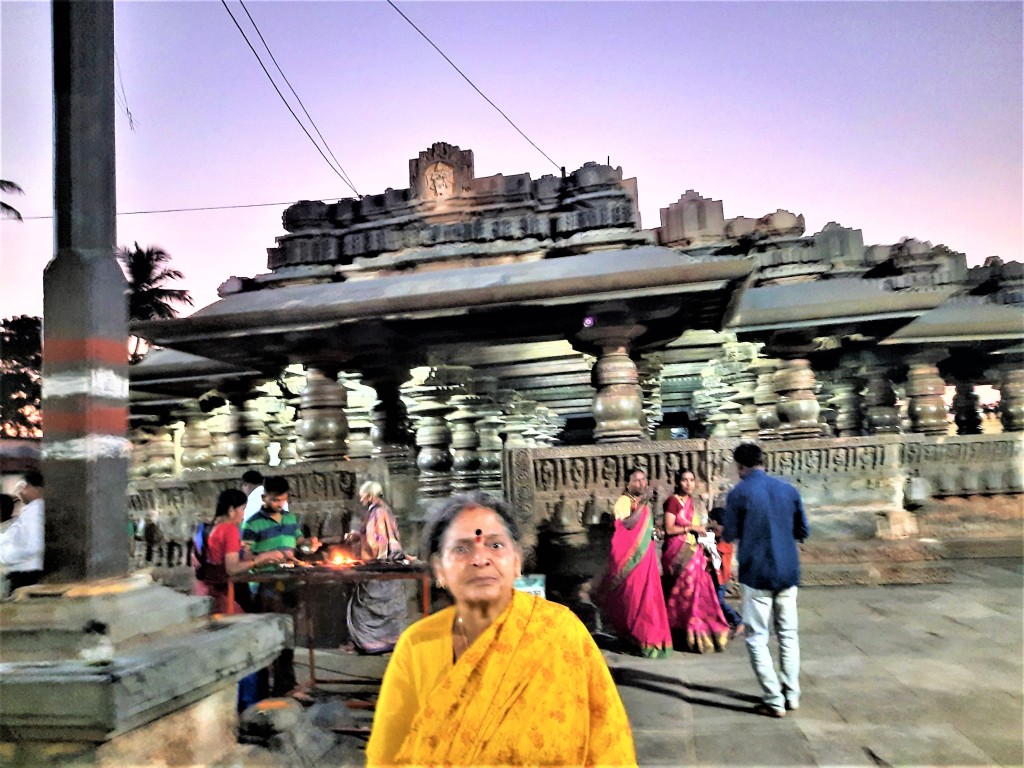
A microscopic image of Goddess Lakshmi represented on the lintel of the doorway testifies the architectural proficiency and inimitable craftsmanship of the Hoysala artists. South side of the temple is Vamana avatar with his foot raised high to measure the world. Shiva and Ganesha idols are carved on the south wall.
The Harihareshwara temple is described as the Kashi of South India. The ‘Harihar’ or “Pushpadri’ hill is situated on the seashore. The temple was constructed during the era of Shivaji Maharaja.The sculptures and carvings clearly reflect the era of Bajirao Peshawa who ruled in the year 1723.
Other places of interest close to Harihareshwar are : 1) Tourists will love visiting the Harihar hill that is located on the seashore. 2) The Kalbhairav temple is yet another ancient temple close to the Harihareshwara temple.3) Bagmandal was home to the Peshawas and is a popular tourist spot.4)The Bankot Fort is an ancient fort and one can get to see the interesting events here.5) Shrivardhan is a beautiful pristine beach close to Harihareshwar. Tourists will love the soothing and peaceful atmosphere here.
6 Day 8
On Day 8 had darshan of Anekonda Basaveshwara Temple, Davanagere – built by Hoysalas ,Kalleshwara Temple, Bethuru- built by Cholas. Then visited Santhebennur Pushkarni -built by Vijayanagara empire, and Bayalu Ganapathi Temple, Holalkere – 20 feet tall Ganapathy temple built by Nayaka rulers clan of Chitradurga. Then visited Kalyani Chalukya temples at Horakeredevarapura and , Hiriyur followed by Sri Ranganathaswamy Temple, Nandihalli, Hiriyur. Details of the temples are given below.
6.1 Anekonda Basaveshwara Temple,Davanagere
Anekonda Shree Kshetra Basaveshwara Temple, 21th ward, Bethur road, 1st Main 1st Cross Rd, Anekonda, Davanagere, Karnataka 57700 Anekonda Shree Kshetra Basaveshwara Temple is located at Anekonda’, a suburb of Davangere town, Karnataka .
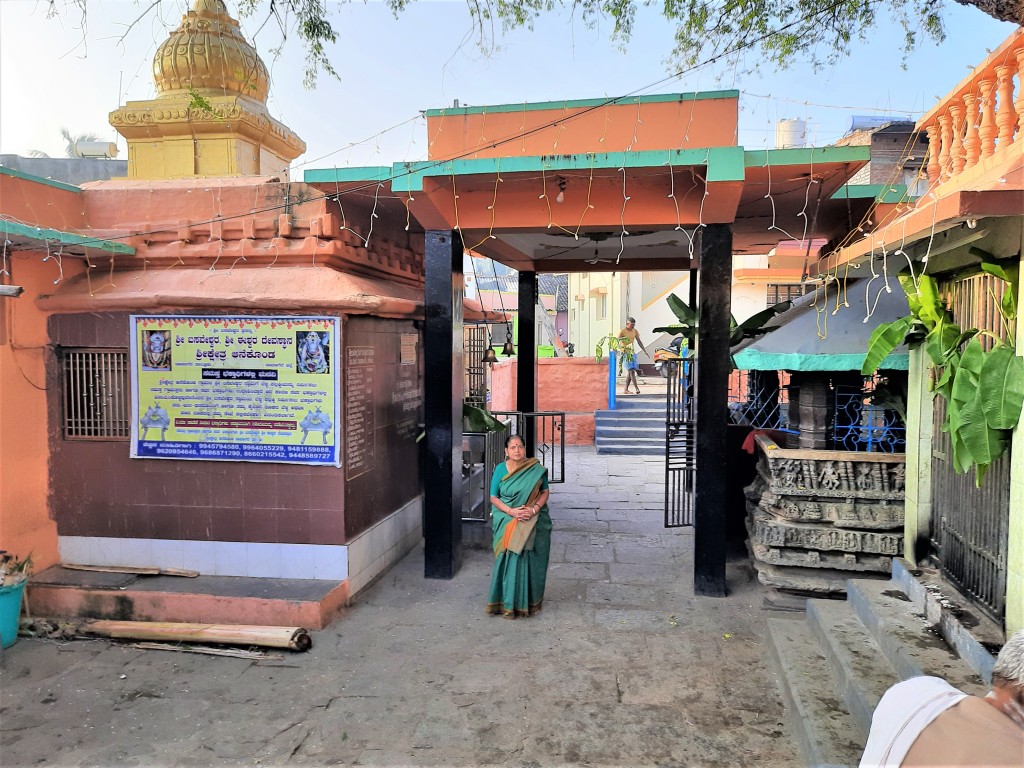
It is a beautiful Sri Eshwara Temple which is small in size , built during the 11th century. Anekonda gets its name due to the army of elephants being tied here when Bethuru was the capital city of Chalukyas. This town was ruled by various dynasties starting from the Gangas, the Cholas, Chalukyas, Uchchangi Pandyas and the Hoysalas. This temple is believed to have been built by the Hoysalas though the style seems inclined more towards the Chalukyan architecture. The temple finds its mention in the 12th century Pandya and 13th century Hoysala inscriptions. The pillars here bear the trademark of Hoysala architecture of being stellar in plan
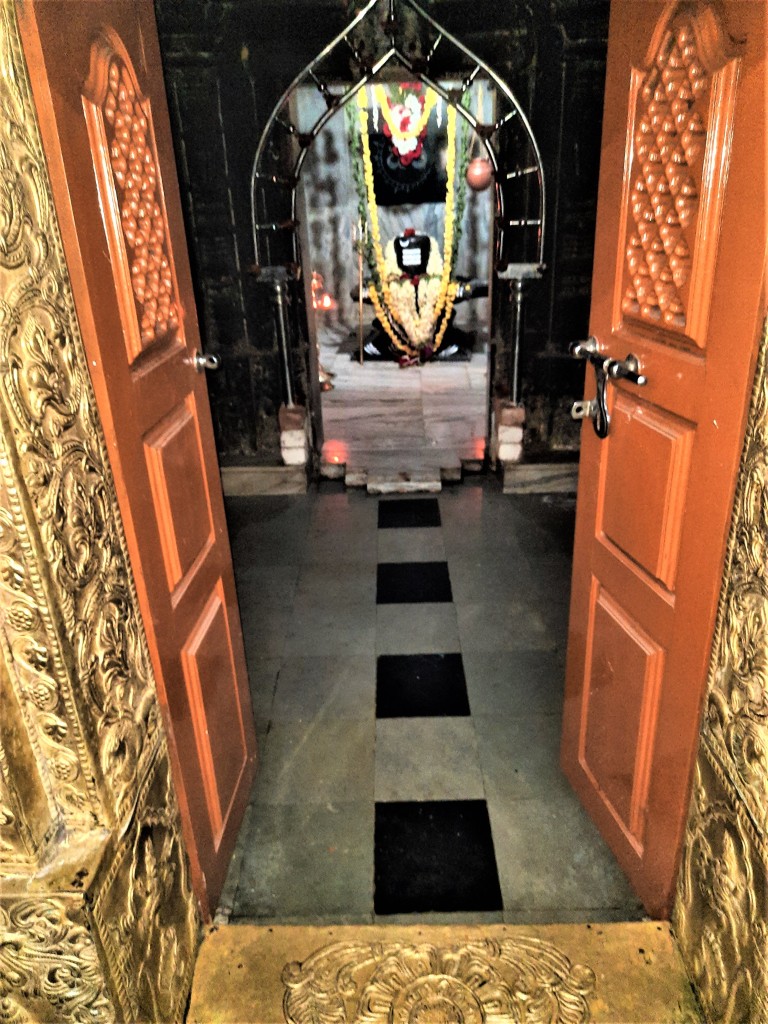
The temple has been carefully renovated taking care to retain the old structure wherever possible. This temple was built on a raised platform. Originally a dwikuta temple as per initial plan, it has now been converted into a trikuta temple as one of its mukhamandapa has been transformed into a garbhagriha during renovation. This temple is dedicated to Lord Shiva and the main garbhagriha houses a Shiva linga, while the other garbhagriha remains empty.
The central ceiling of its Navaranga has one of the most exquisitely carved Gajasurasamhara flanked by Lords Vishnu and Brahma. In the panel below are 7 Goblins associated with Lord Shiva who are shown playing music for the Lord’s dance. In the panel above are 12 Adityas, the sons of Goddess Aditi. The other eight Ankanas of the Navaranga have shallow lotuses with their pendants bearing the carvings of their respective Dikpalas.

Right in front of this temple is a small mandapa dedicated to Lord Nandi. The front porch on both sides have 5 friezes with sculptured railing at the top. In the top panels are various figures such as those of the Dwarapalakas, dancing Ganesha, rishis, Rati-Manmatha, goblins and other erotic figures. The ceiling of the eastern mukhamandapa has carving of Lord Indira riding on the elephant Airavata at the center accompanied by heavenly musicians.
6.2 Ancient Kalleshwara Temple, Bethuru
Ancient Kalleshwara Temple, FWRV+FFH, Bethuru, Karnataka 583125 Ancient Kalleshwara Temple is located at Bethuru, Karnataka at a distance of 5 kms from Davangere.- which should be famous for its Chola temple but in reality very few know about its existence.
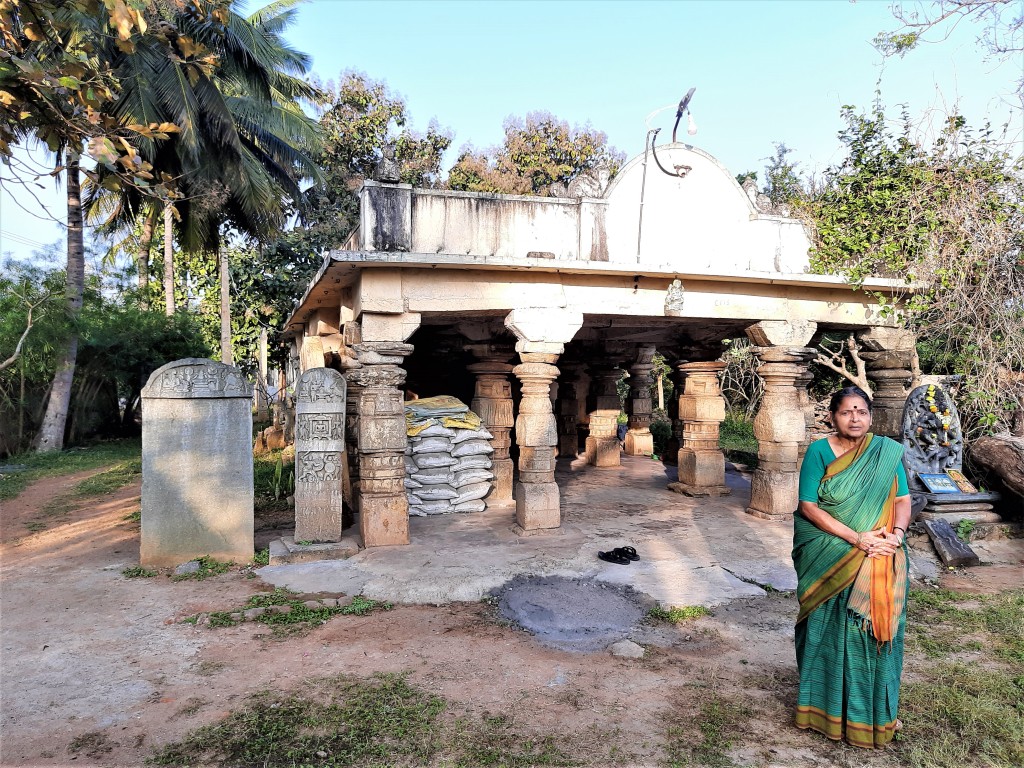
There are quite a few temples in this region and Northern Karnataka built by the Cholas in the post Badami Chalukyan era. Sri Basaveshwara temple at Hallur of Bagalkot district, also built by the Cholas around 8th century. It is very surprising to find such a temple in a territory which is which otherwise is dominated by the Art and Architecture of the Hoysalas and Chalukyas. A cursory look on the temple vimana force us to compare its counterparts in Tamilnadu like Panangudi and Kaliyapatti or early temples of Pattadakal in Karnataka. The shikhara is constructed in stepped manner which is characteristic of Kadamba style. It is not constructed in stories (tala-s) like that of Panangudi and Kaliyapatti where both are ektala (one story).

The temple would have been extended with a mandapa at a later time. During this extension, a marvelous ashta-dikpala panel was inserted in the middle of the mandapa ceiling. Shiva as Gaja-samhara-murti is in center and he is accompanied with eight directional guardians. All the guardians are riding over their mounts and accompanied with their consorts, except Nrrtti who is shown alone.
There is no antarala (vestibule) in the temple, the garbhagrha (sanctum) is directly connected to the mandapa. The garbhagrha door has dvarpalas at bottom accompanied with three female attendants and one male attendant. In the mandapa are placed Saraswati and Sapta-matrika sculptures.
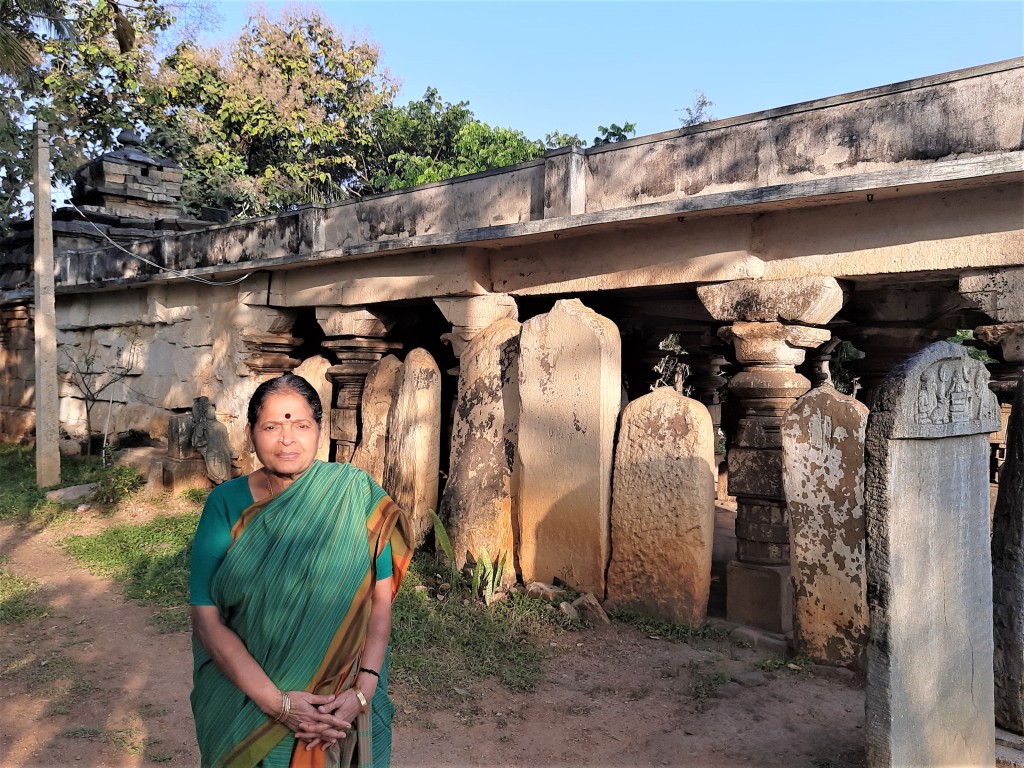
This temple was built either by Rashtrakutas or Nolambas between the 8th and 9th centuries. Later between 11th -13th century, this temple under went a few additions/renovation under the Kalyana Chalukyas/ Uchangi Pandyas/ Hoysalas. Many hero-stones found here which are now kept near the temple belong to these dynasties. The most pleasing sight here is that of a beautiful carving on the ceiling panel of ‘Gajasura Samara/ Gajasurasamhara’ (depiction of Lord Shiva slaying the elephant demon Gajasura) in the central portion, surrounded by the Ashtadikapalas.

The temple is dedicated to Lord Shiva in the form of a Linga, with murtis of goddesses Saraswathi and Sapthamatrikas and Lord Subramanya kept in the Navaranga of the temple. The Shikara of the temple is a perfect example of early Cholan architecture.
It is very sad that such a beautiful temple in a sheer state of neglect, without any care or maintenance. . Though there are no daily pujas/rituals being performed here,by a self appointed care taker. A lot of snakes happen to visit this temple regularly and embrace the Shiva Linga here, This temple definitely needs and deserves more care and maintenance in order to be preserved for future generations.
6.3 Santhebennur Pushkarni
Santhebennur Pushkarni, 5283+JVQ, Santhebennur, Karnataka 577552 Santhebennur Pushkarni, is located at , Santhebennur, Karnataka at a distance of 37 Kms from Davangere.
Santhebennur has a historical pushkarini (sacred pond), which is known for its architectural beauty and the history of Santhebennur is closely linked to the pushkarini. The region was a part of the Vijayanagar empire, and Kenga Hanumantappa Nayaka, a local palegar, built a Rama Temple and a pushkarini here in the 16th century. God Rama was the family deity of the Nayaka rulers. Now, even after five centuries,.the structure remains intact. Today, the pushkarini with a majestic mantapa at the centre is considered to be one of the magnificent structures of South India.

It is said that the Vasanta Mantapa, at the centre of the pushkarini, was built to commemorate Kenga Hanumantappa Nayaka’s victory over the rulers of Bijapur. The sides of the pushkarini, also known as Santhebennur Honda, are veneered with granite steps. There are 52 granite steps from the main entrance in the west direction and 44 steps in other three sides. Initially, there were eight towers at the cardinal points (representing eight directions). However, of these eight, only six remain intact now
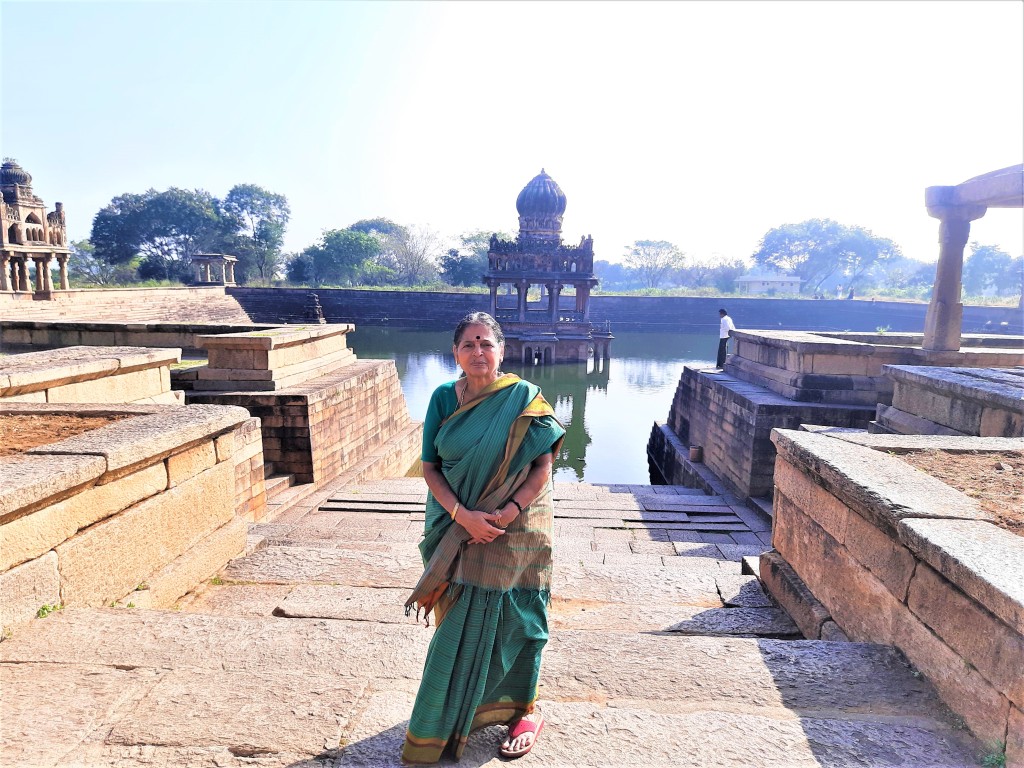
The pond spans over an area of about 250 feet (length) and 240 feet (width), with a depth of over 30 feet. The Vasantha Mantapa is a symmetrical pillared tower and exhibits Indo-Arabic style of architecture. The multi-level mantapa covers .an area of about 34 square feet. While the arches, vaults and domes of the mantapa represent the Arabic style; its columns, pyramidical towers and carving embody Indian style of architecture.
The mantapa is built in such a way that, for an onlooker on the banks of the pushkarini, it appears to be floating on water. It is said that the mantapa has a water storage facility at its base and supplies water to an inbuilt working fountain. .This feature of the mantapa gives it another name — karanji mantapa (fountain mantapa).

Different geometrical figures, specifically flowers, adorn each floor, enhancing its beauty. These artworks exhibit the ingenuity of artists of that era. The first floor has similar openings on all four sides. The top floor has a hemispherical dome embedded with carvings.
The pond was used to perform teppotsava, or floating festival, of the deity. As per the ritual, the utsava murthi of the main deity was taken out of the temple and was placed on a decorated platform on a boat and taken around the pushkarini.
Later in the 17th century, the army of Bijapur sultan led by commander Ranadullakhan invaded Santhebennur. Ranadullakhan, along with his followers Pattekhan and Faridkhan, constructed a musafirkhana (a place to rest) on the bank of the pond. The premises of the pushkarini is being maintained by the Archaeological Survey of India — Bengaluru Circle (ASI). Within this premises, one can find a beautifully maintained garden as well
6.4 Shri Bayalu Ganapathi Temple, Holalkere
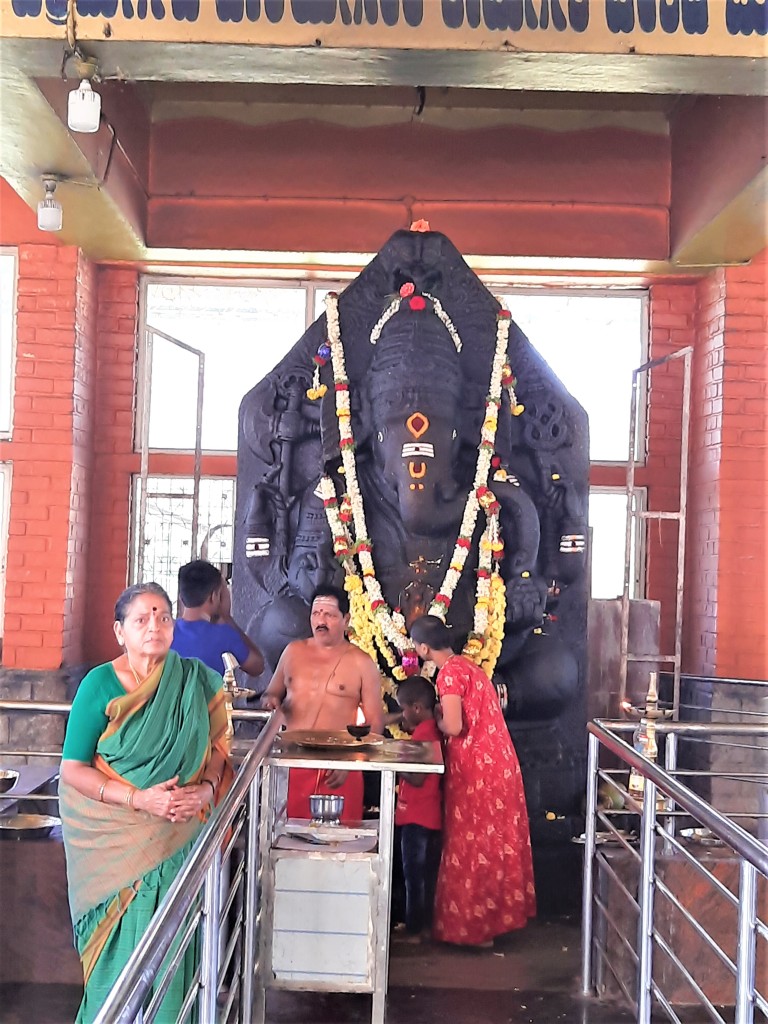
Shri Bayalu Ganapathi Temple, Holalkere, Karnataka 577526. Shri Bayalu Ganapathi Temple is located at Holalkere, Karnataka at a distance of 60 kms from Davangere

The golden coloured temple tower is highly attractive with figurines of gods and goddesses. A 20 ft high, monolithic statue of Lord Ganapathi – cut out of a solitary stone.. The temple was built in 1475 AD by Guthyappa Nayaka, from the Nayaka rulers clan of Chitradurga, According to local legends, if one worships Ganesha’s statue with true devotion, their wishes will be fulfilled.
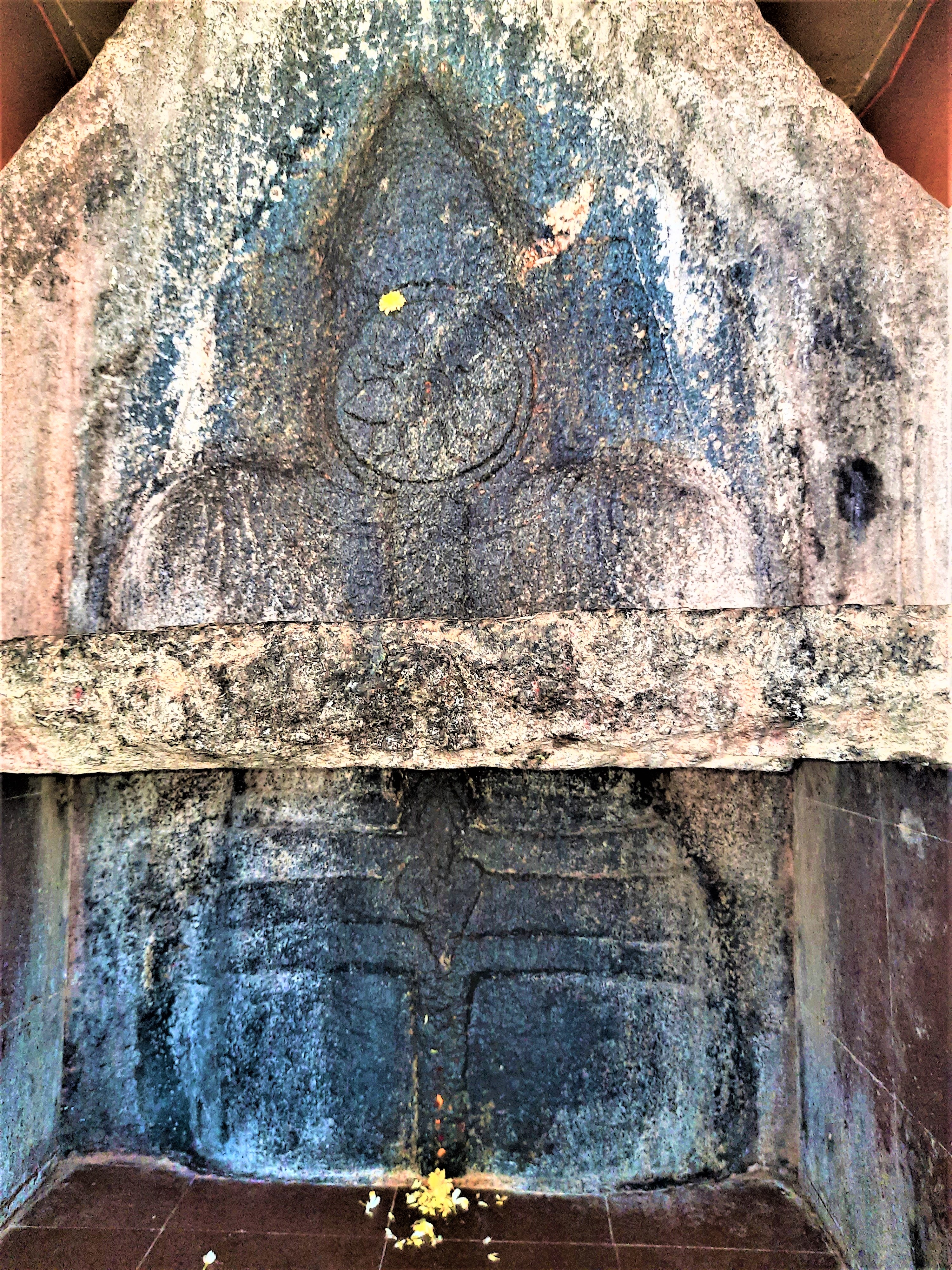 | 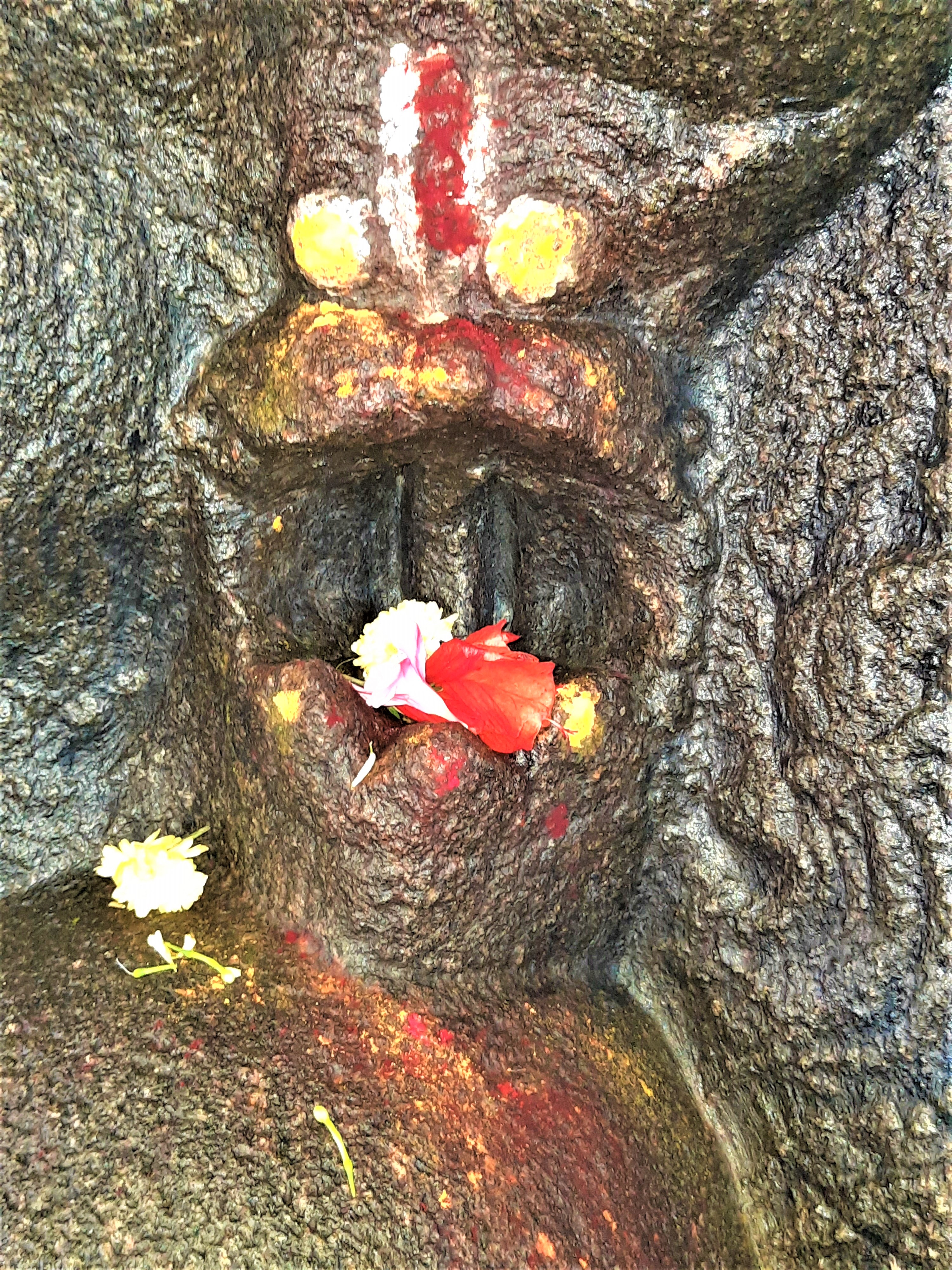 |
This Ganesha has plaited / entwined hairs, earning the nickname “Jade Ganapathi“.- the jade is attributed to Goddess Parvathi and it can be seen behind the idol; of Ganesha, Also on the left side of Ganesha, one can see Lord Narasimha face. Hence it is believd that Lord Narasimha also resides in Ganapathy along with Goddess Parvathy.
The temple is open from 6 am to 9 pm – open through out the day.
6.5 Lakshmi Narasimha swamy Temple, Horakeredevarapura
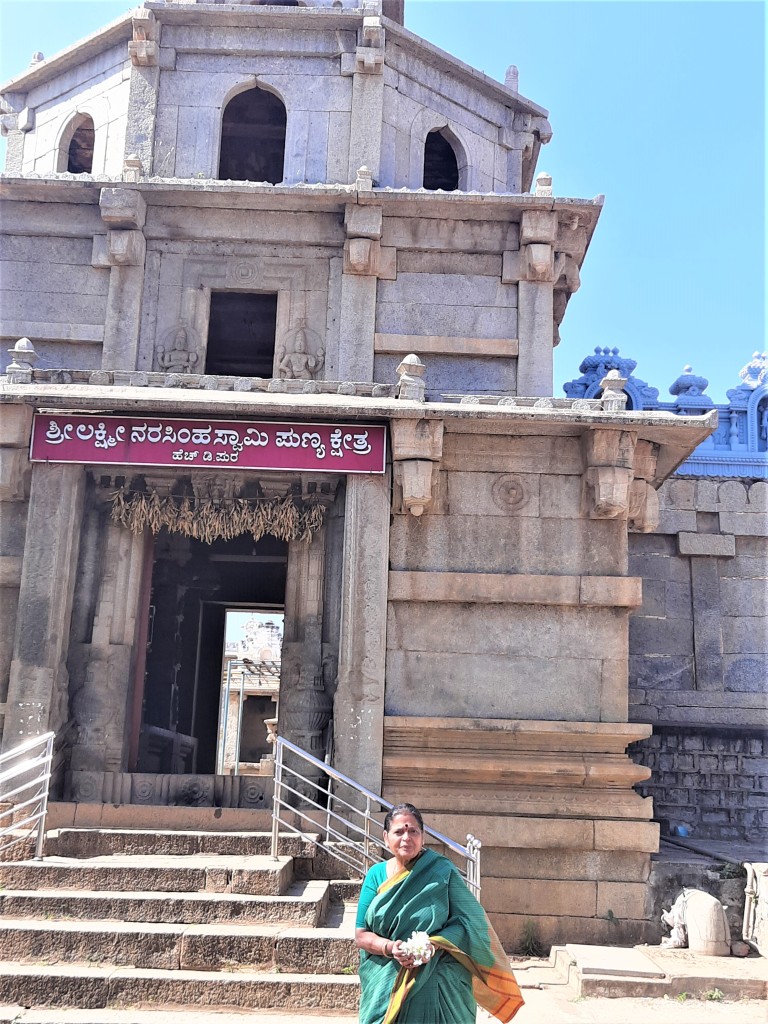
Sri Lakshmi Narasimha swamy Temple, 28MG+4W6, Horakeredevarapura, Karnataka 577557 Sri Lakshmi Narasimha swamy Temple is located at Horakere devarapura, Karnataka at a distance of 88 kms from Davangere and 30 kms from Chitradurga.
A unique, magnificent and huge Rajagopura (an entrance gateway) built of stone is at the entrance to temple. It has some structural resemblance to the gateways of Hampi and Chitradurga,This temple has been constantly renovated time to time under various dynasties. We could see some minor contributions of our generation too. The idol of Lord Lakshmi Narasimha is very beautiful . The temple complex is vast with many of the structures belonging to the Vijayanagara period, except for the basic temple (Garbhagriha) and the beautiful idol belongs to the Hoysalas
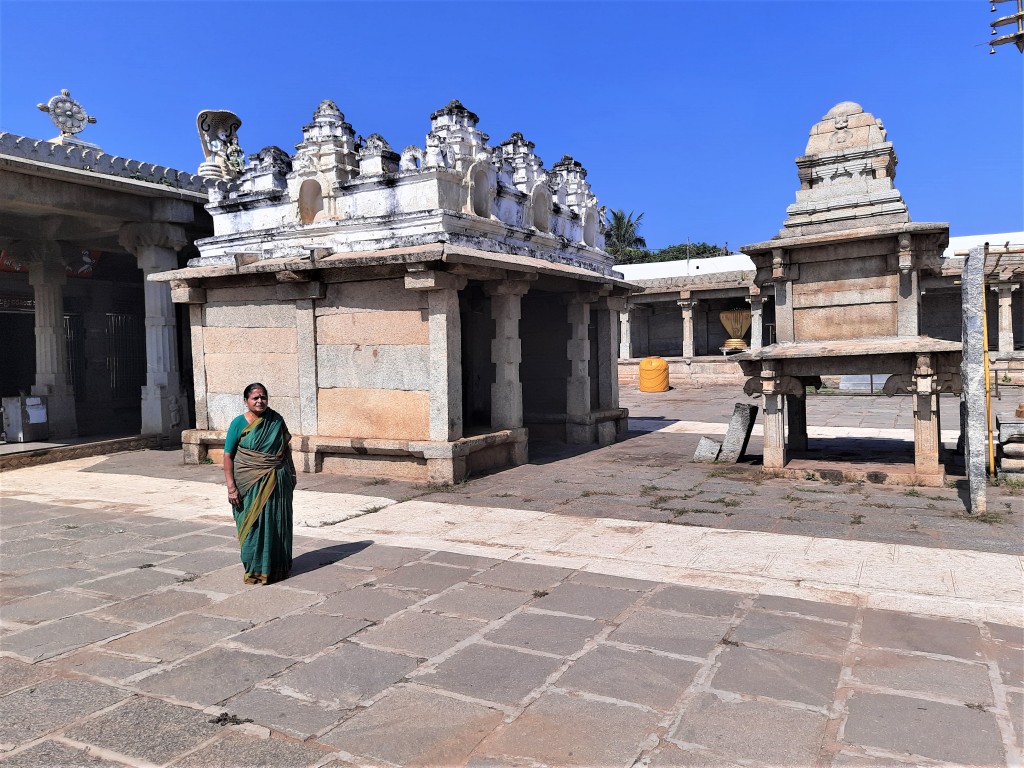
As per the legend, this place was formerly called Nanjundarajapattanam as it ruled by a cruel king named Nanjundaraja. He had a bad reputation of being demonic, ill treated people who visited other pilgrimages and was against people worshipping god. One day, Lord Venkateshwara (Vishnu) being aware of all the happenings decides to teach this king a lesson and free the people of his town from his evil deeds. On reaching the town, the lord decides to be seated atop a hillock named Krishnachala Betta in order to protect the people. He destroys the king and his palace within no time. The people of the village then performed Puja to this hill and requested the Lord to stay back in their village. He decides to stay back, though in his other form of Lord Lakshmi Narasimha just outside the village nearby a lake, and hence the Horakere Devapura (Hora-outside; kere-lake; Deva-god; pura-village). There are many more stories from this place.
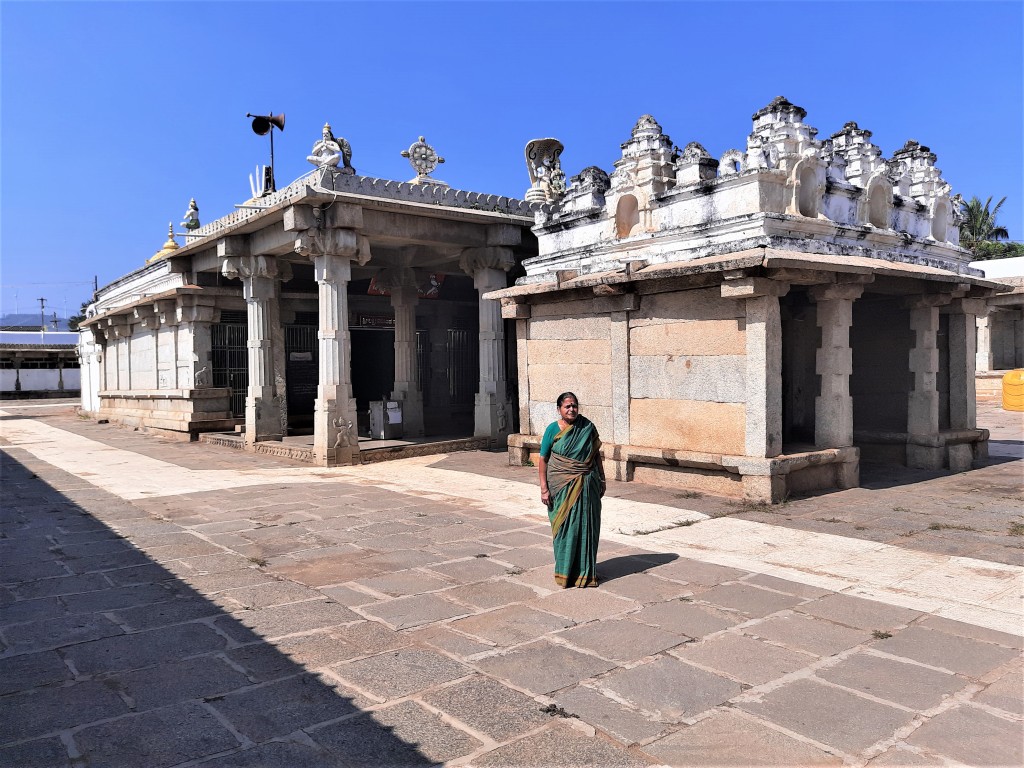
Must have darshan of the ancient and big temple.
6.6 Sri Therumalleshwara Temple,Hiriyur
Sri Therumalleshwara Temple ಶ್ರೀ ತೇರುಮಲ್ಲೇಶ್ವರ ದೇವಸ್ಥಾನ , T T Road, Doddakalla Sandhra, Hiriyur, Karnataka 577598 Sri Therumalleshwara Temple is located in the heart of the Hiriyur town on the banks of river vedavathi,, Karnataka at a distance of 40 Kms from Chitradurga.The Teru Malleshvara temple is a protected monument under the Karnataka state division of the Archaeological Survey of India.
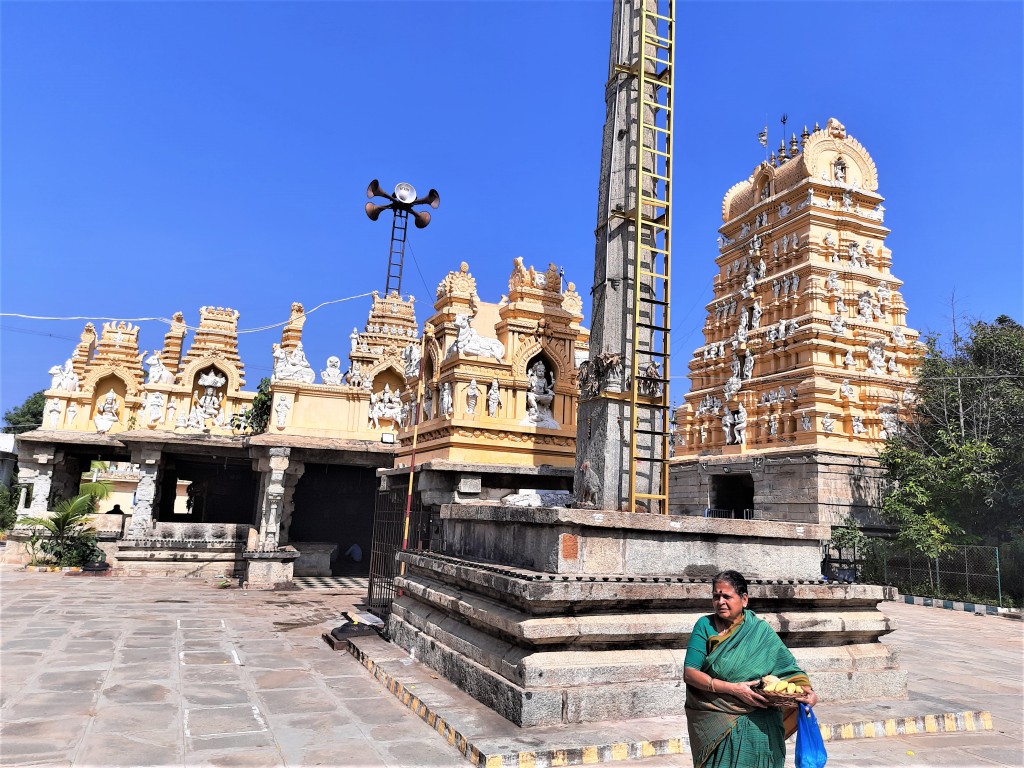
The temple exhibits the Dravidian style of architecture with a tall gopura (superstructure over entrance gate). The ceiling of the mukhmantapa (entrance hall) has murals depicting scenes from the “Shivpurana” (Hindu Shaiva epics) and the Ramayana (the Hindu Vaishnava epic). The temple dates built around c.1466, during rule of the Vijayanagara empire.

Teru Malleshwara Temple is also called as Dakshina Kashi (Kashi of the South). This 500 year old temple has attractive pillars and ancient sculptures. Teru Malleshwara temple features a tall tower along with a 45 ft high lamp and that is lit just once a year. The lamp includes eight lamps which store 10 seers of oil.

It is believed that famous devotee of Lord Shiva, Belavadi Mallamma who was residing in the town used to travel to Varanasi every year by walk. As she become older and weaker, she could walk to Varanasi to offer her prayers. So one day she prayed to Lord Shiva and told that because of her old age and weak, she could not visit Varanasi. Pleased by her prayers, lord Shiva appeared in her dream and told her that ‘Don’t come to Varanasi, I myself will come and reside in Hiriyur. As promised lord Shiva was believed to have incarnated in the Oralukallu (a cylindrical shape stone which used in the households for grinding purpose). That stone which was worshipped by Mallamma later became known as Teru Malleshwara.
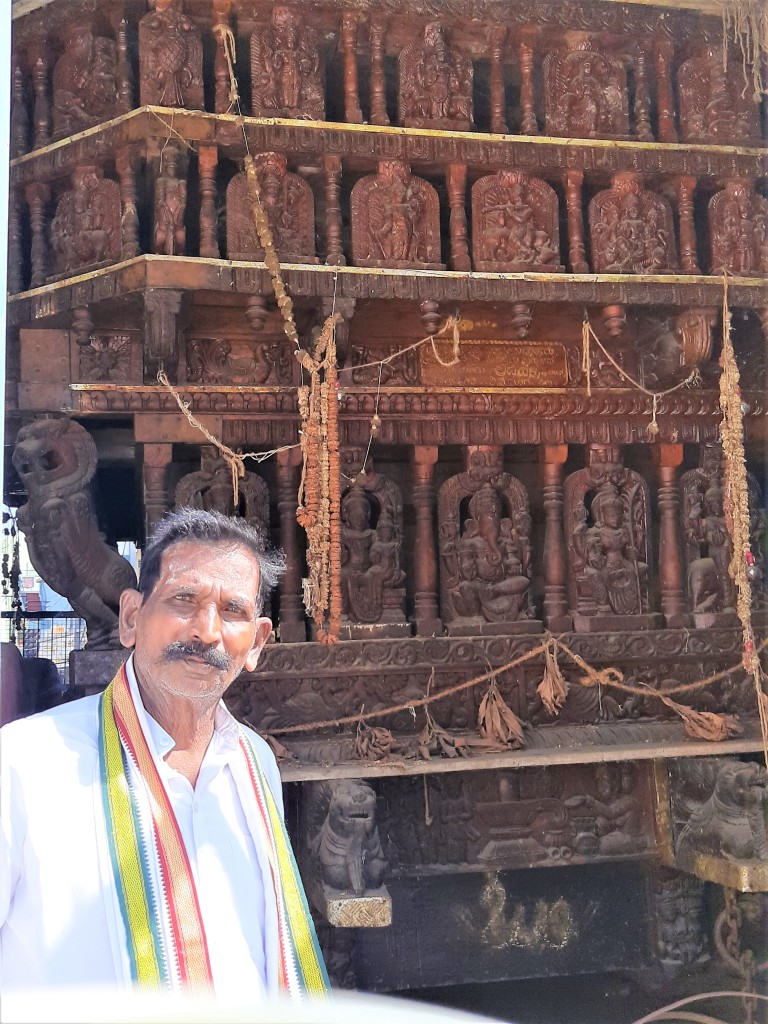
There is a seperate small temple / sannadhi for Kalikamba devi within the Sri Therumalleshwara Temple premises. One speciality in Sri Therumalleshwara Temple is a Shiva Dhanus – bow used by Lord Shiva for Tripurs samhara. Once in a year, the dhanus is taken out for ganga snana in Vedavathy river. More than 100 persons are required to carry the dhanus ! After this event, rathothsava takes place.
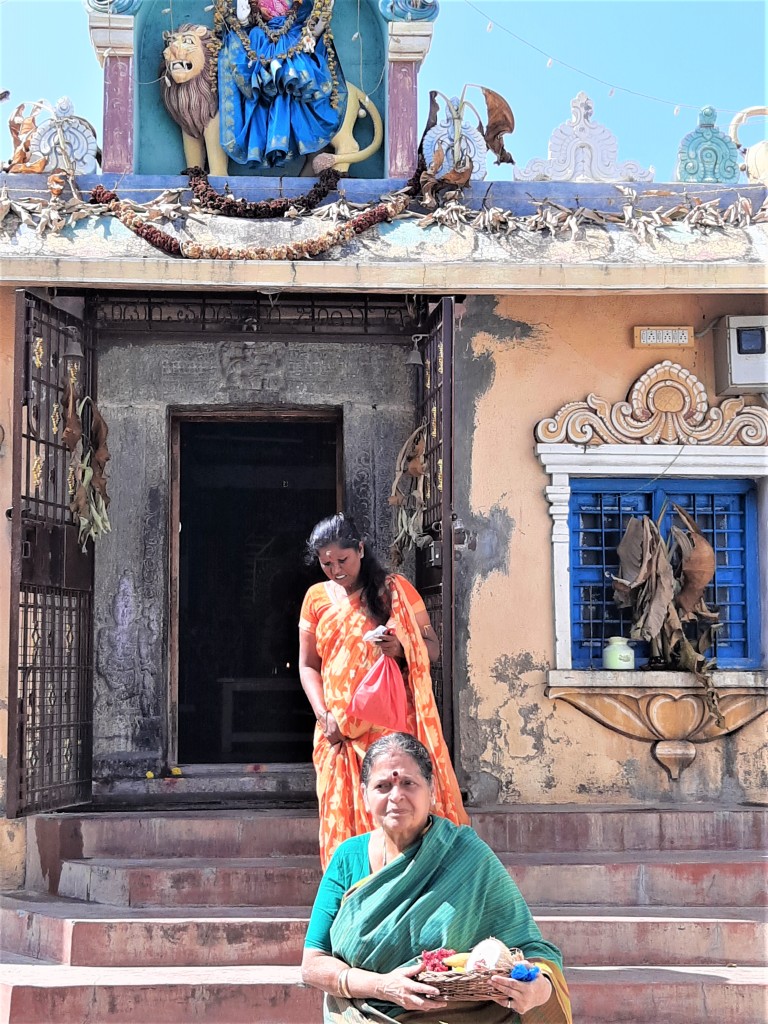
The “Teru Malleshvara” fair (Jatra, a religious gathering with festivities) is celebrated annually for a week starting from the full moon in January or February (called magha)

Temple timings are 6 am to 6 pm – open through out the day. Contact phone numbers are : 9964057070 Mallesh Acharya. Bhojraj -Palayakar -8971506845.
6.7 Sri Ranganathaswamy Temple, Nandihalli, Hiriyur
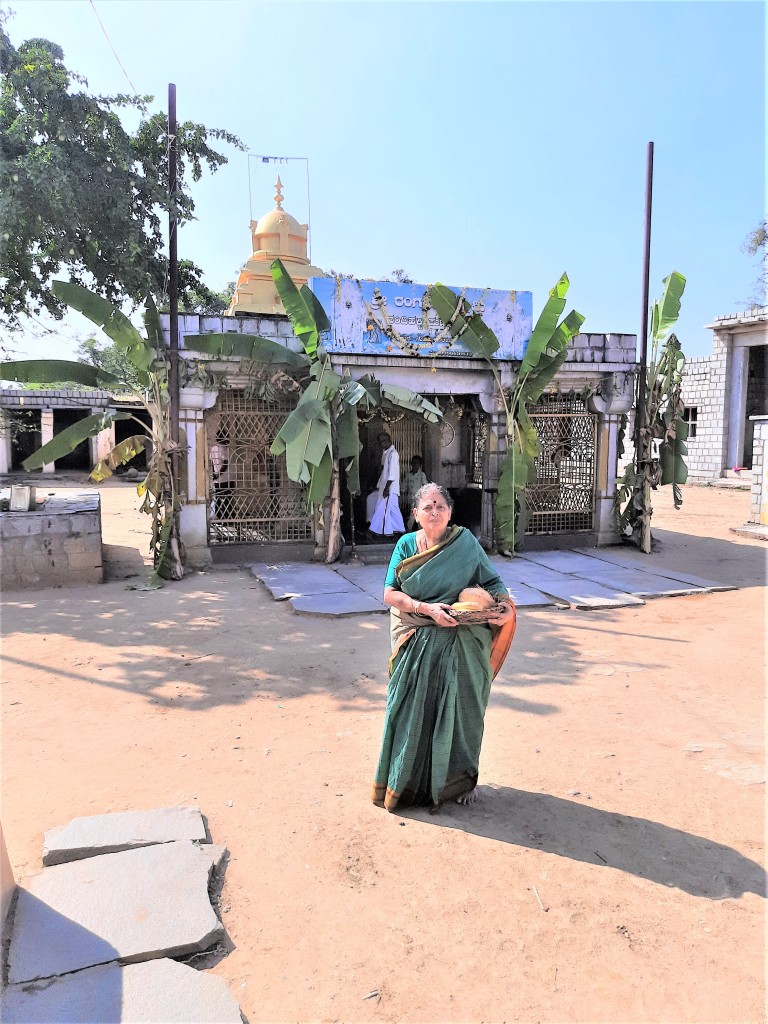
Sri Ranganathaswamy Temple, WMJC+8G4, Nandihalli, Hiriyur, Karnataka 577511 Sri Ranganathaswamy Temple, is located at Nandihalli, Hiriyur, Karnataka at a distance of 49 kms from Chitradurga and 8 kms from Hiriyur.
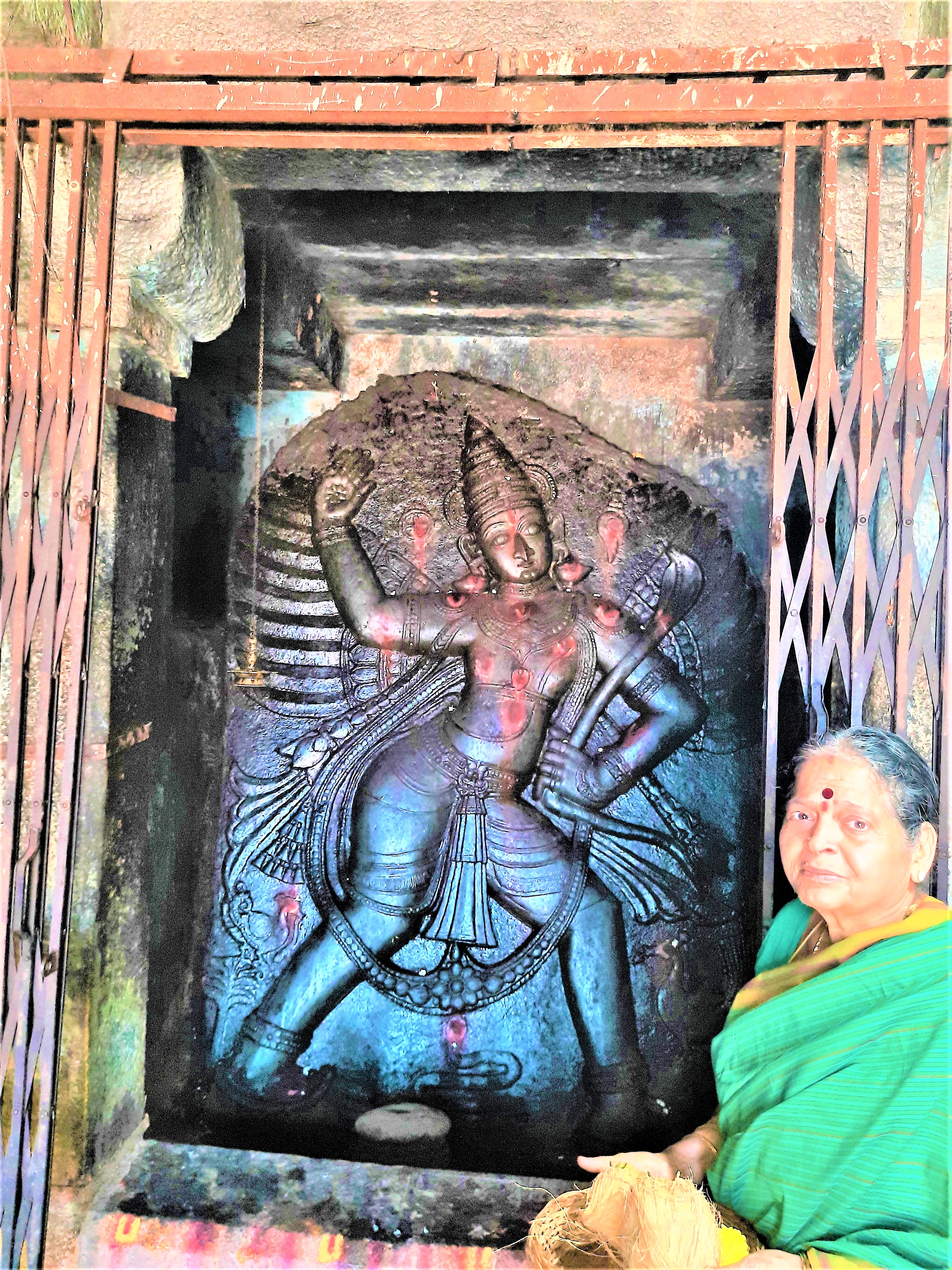 |  |
Nandihalli is a small village in which Sri Ranganathaswamy Temple is situated. The entrance to the small temple has been built recently . Beautiful Lord Ranganathaswamy is in a standing pose. There are 2 excellent Garuda and Anjaneya shilas – 6 feet tall in seperate sannadhis. Calm and serene temple.

